Computer Supported Collaborative Work (CSCW)
1/124
There's no tags or description
Looks like no tags are added yet.
Name | Mastery | Learn | Test | Matching | Spaced |
|---|
No study sessions yet.
125 Terms
What is Computer Supported Collaborative Work (CSCW)?
CSCW is the study and theory of how people work together, and how the computer and related technologies affect group behaviour (Greenberg 1991).
CSCW examines the possibilities and effects of technological support for humans involved in collaborative group communication and work processes (Bowers and Benford 1991).
What are collaborative technologies?
Collaborative technologies = CSCW + Group Support Systems (GSS)
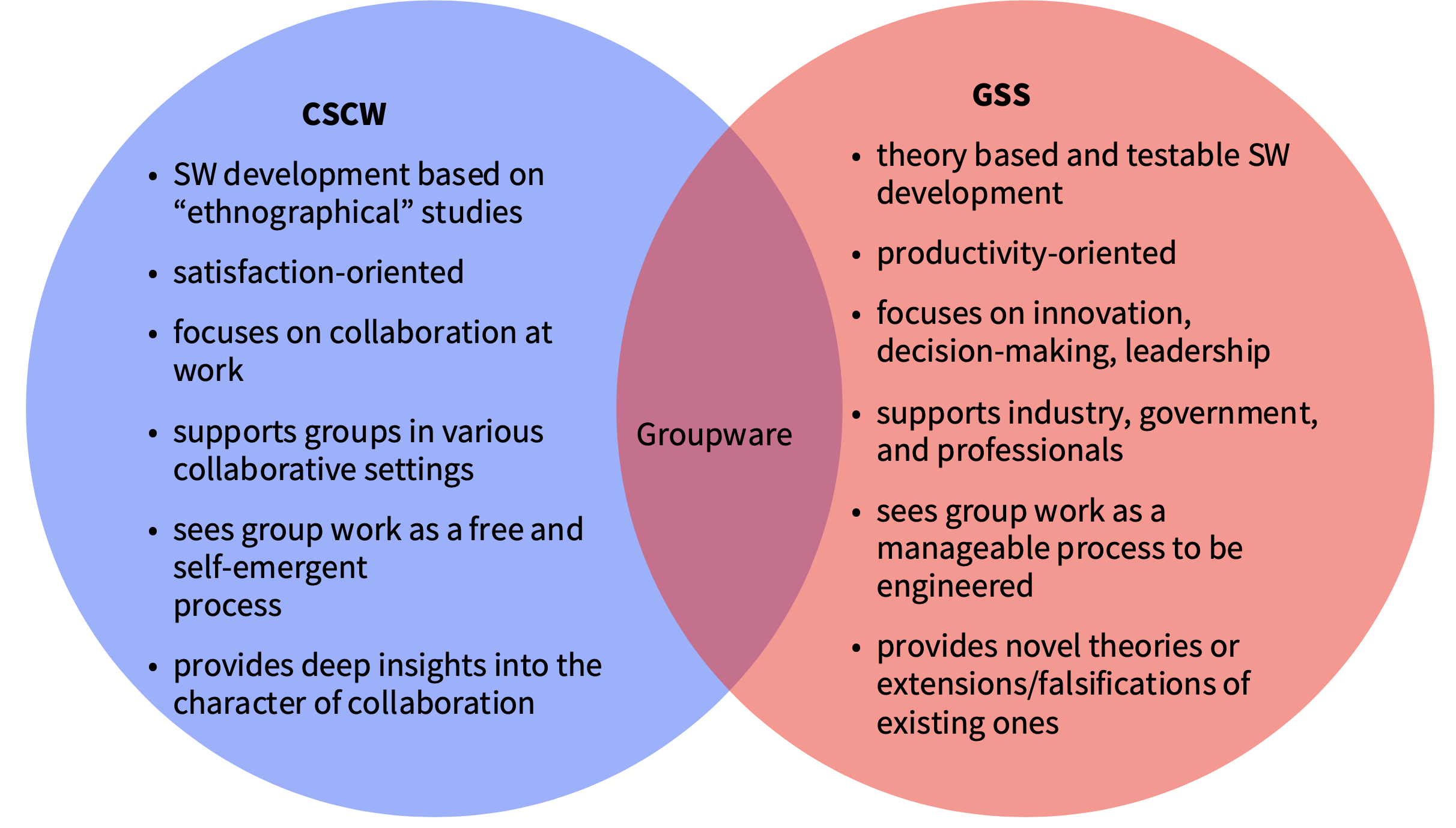
Give an example of how interests can be different.
A customer wants to have their car repaired. The mechanic wants to earn money. The mechanic could thus try to „repair“ damage that doesn‘t exist in order to make more money.
How can messages be misunderstood?
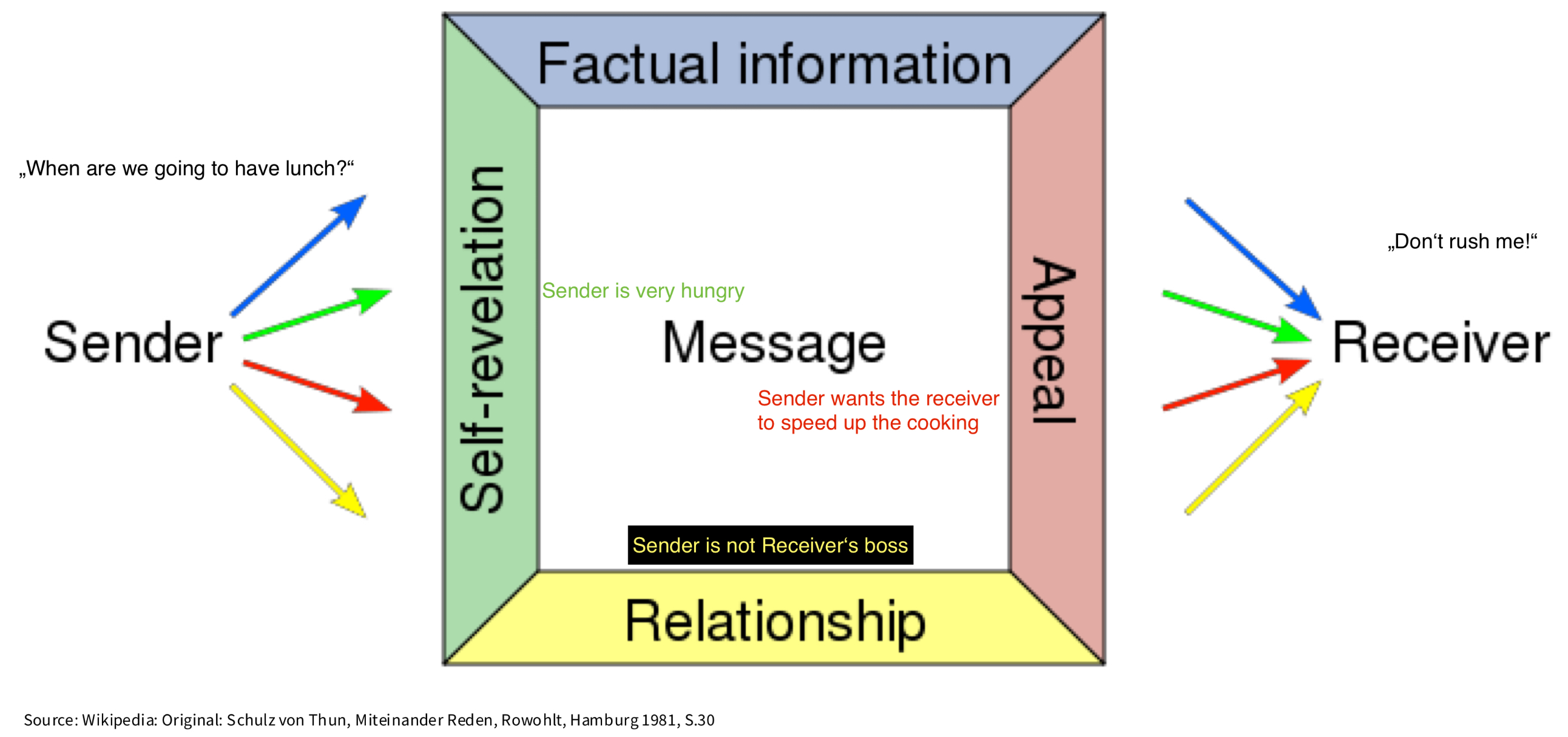
Why do we misunderstand messages?
If the sender asks “When will we have lunch?”, not because they are hungry, but because they just want to know, the receiver can interpret this like this:
Self-revelation: The sender is hungry.
Relationship: The sender is not the receiver’s boss.
Factual information: The sender just wants to know when lunch will be ready.
Appeal: The sender wants the receiver to speed up their cooking.
The receiver then might respond aggressively “Don’t rush me!”, because they thought that the sender was annoyed with the receiver.
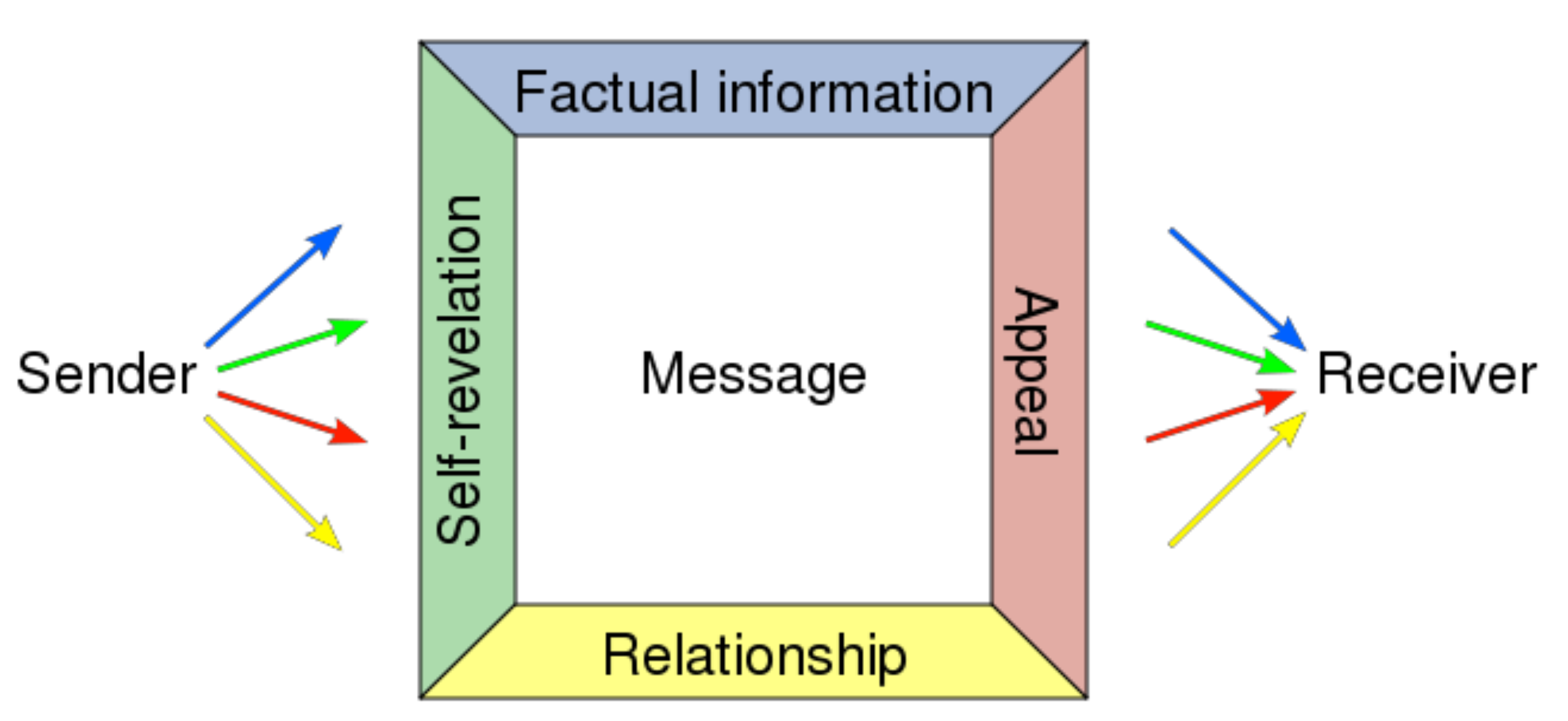
What is the Media Richness Theory?
While math homework is best shared through channels like E-Mail, or SMS, since just observing someone doing their math homework would be inefficient, firing an employee is typically done face to face, since the employee usually wants to know exactly why they are being fired.
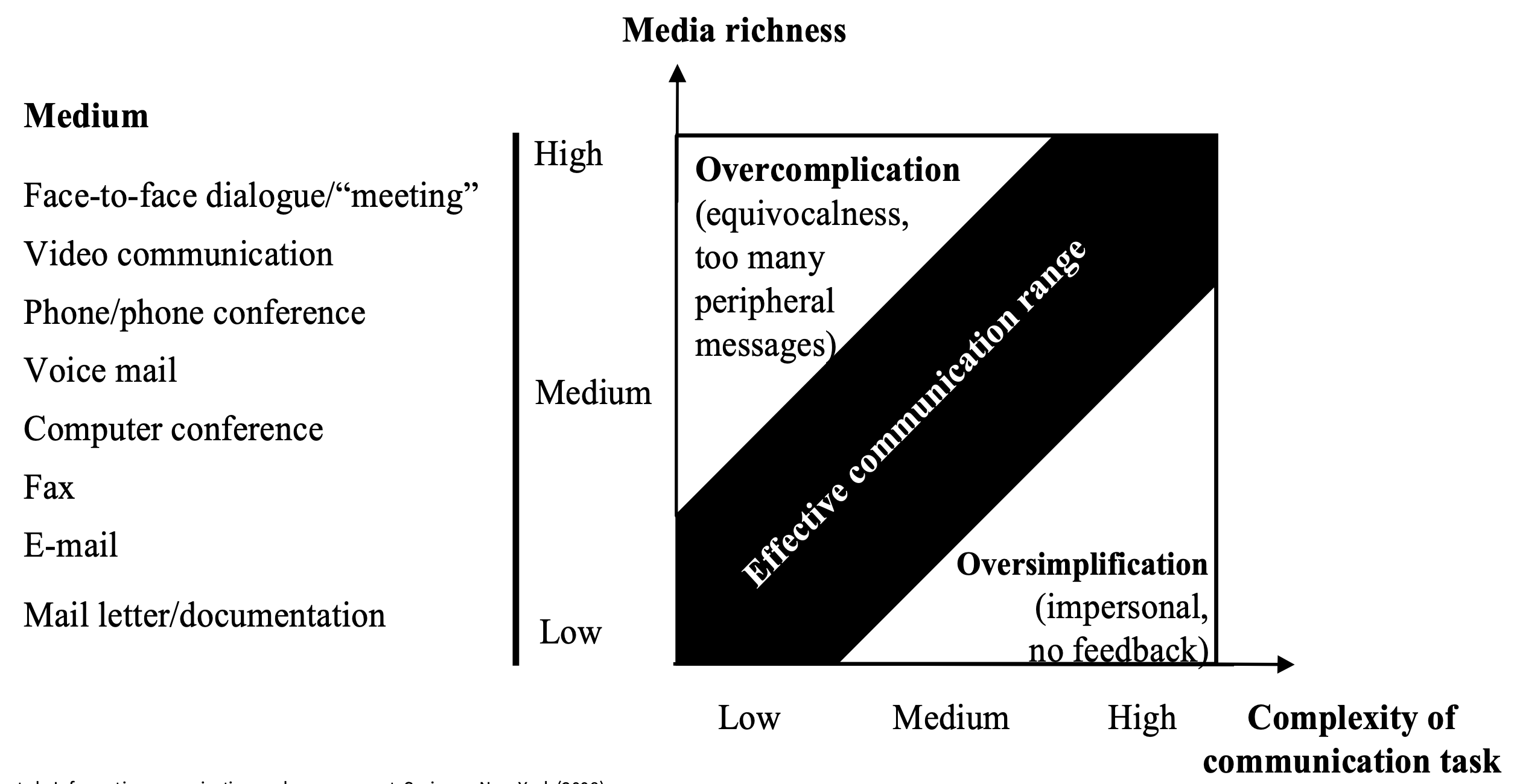
What does media richness depend on?
– Ability to handle multiple information cues simultaneously
– Ability to facilitate rapid feedback
– Ability to establish a personal focus
– Ability to utilize natural language
What do tasks get characterized by?
– the grade of its ambiguity
– the grade of uncertainty
What are tertiary, secondary, and primary objects of collaboration?

What is a mental model?
“A mental model is one’s own view of the world, which determines one’s thinking and one’s action. Mental models are flawed and can be misleading. Through interaction and exchange, they should be brought closer to the reality.” (Haake 2012)
What is shared material used for?
– to create and keep a shared understanding
– in a way that participants can edit
– as a memory of the previous cooperation
→ Where are we? How did we get here? Where do we go?
What are requirements for shared material?
– Editable by every collaboration partner equally
→ Provide direct or indirect access for everyone
– Multiple forms of representations
→ to depict a variety of perspectives on the problem
– Playful handling
→ fostering creativity
What is the People-Artifact Framework?
The Deixis represents a reference to the artifact, e.g. “Figure 2 needs to be edited.”, while the Feedthrough is communication through the artifact, e.g. “Please change this paragraph.”.
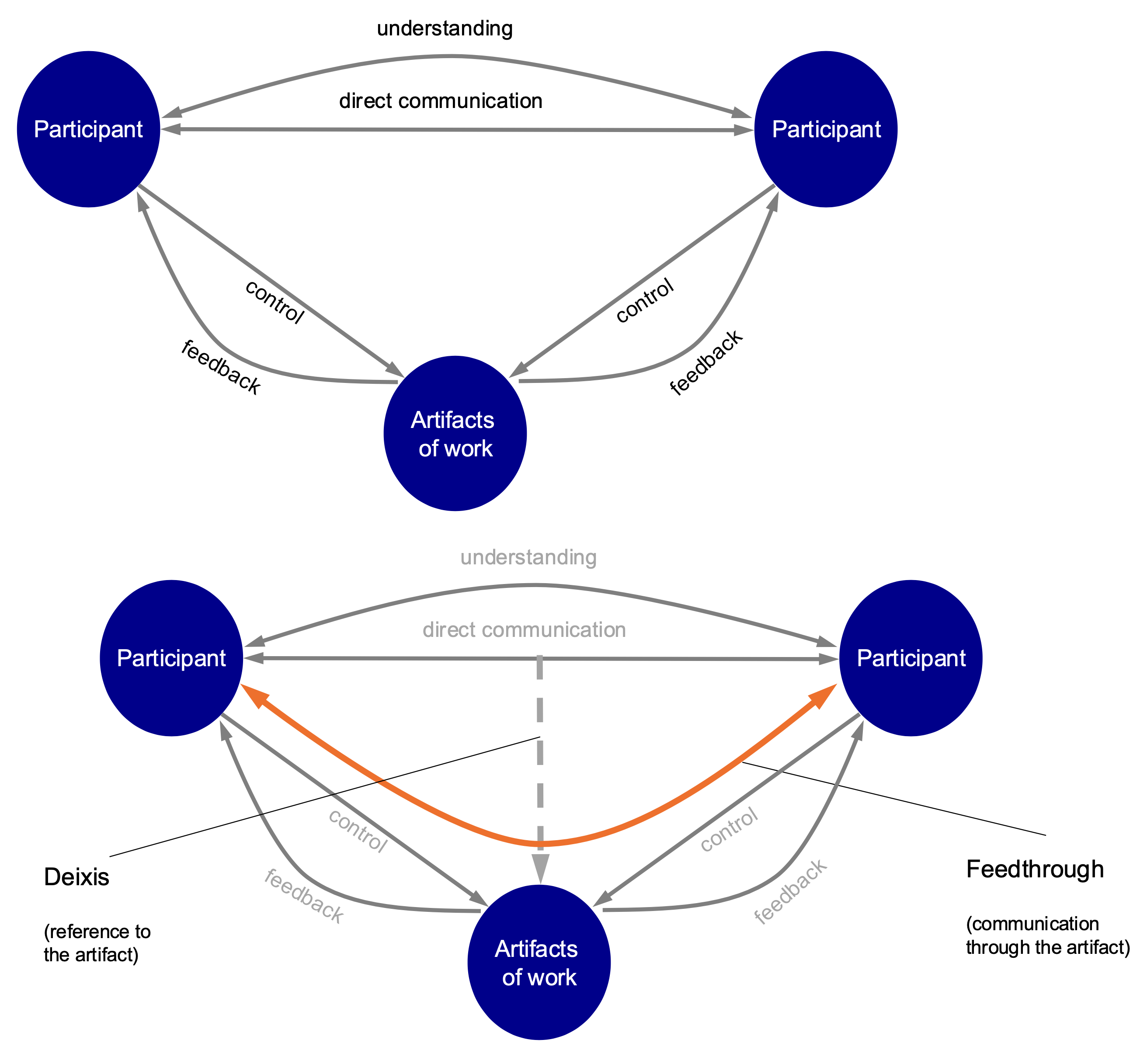
What are examples of types of awareness?
– Group Awareness
– Presence Awareness
– Peripheral Awareness
– Activity Awareness
– Social Awareness
– Situational Awareness
What are examples of “dangerous” multitasking?
– Write mails while you use your phone
– Chat over Skype while you listen to a lecture
– Check answering machine while you talk to someone
– Read newspaper while you follow the radio news
– Drive car while talking on a cell phone (it is even forbidden)
What are examples of “useful” multitasking (stacking)?
▪ Have dinner while you watch TV
▪ Jogging while you use your iPod
▪ Drive car while you listen to the radio
▪ Write mails while you print a letter
▪ Read a book while you get a haircut
What are generic requirements for dyadic collaboration?
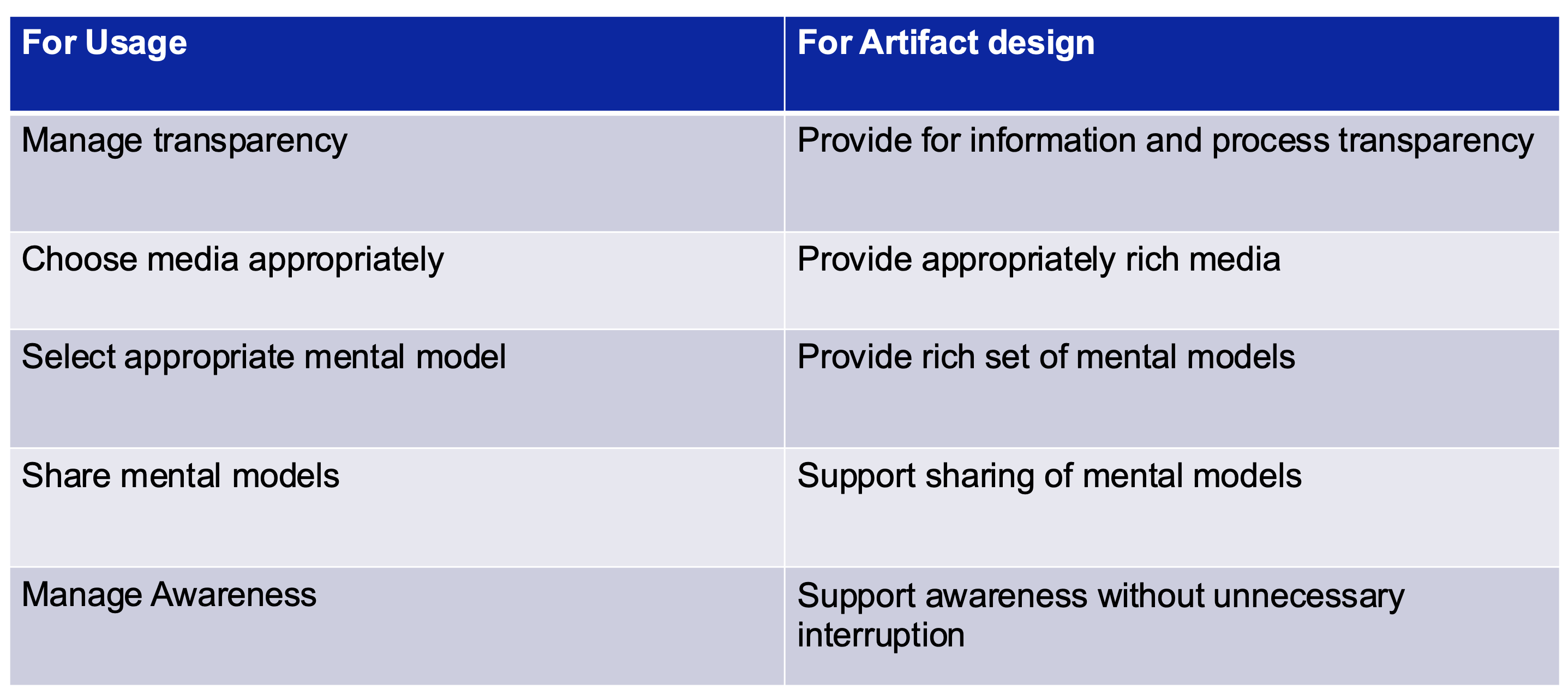
What does the Human Problem-Solving process look like (Simon‘s 3 activities / stages in decision making)?
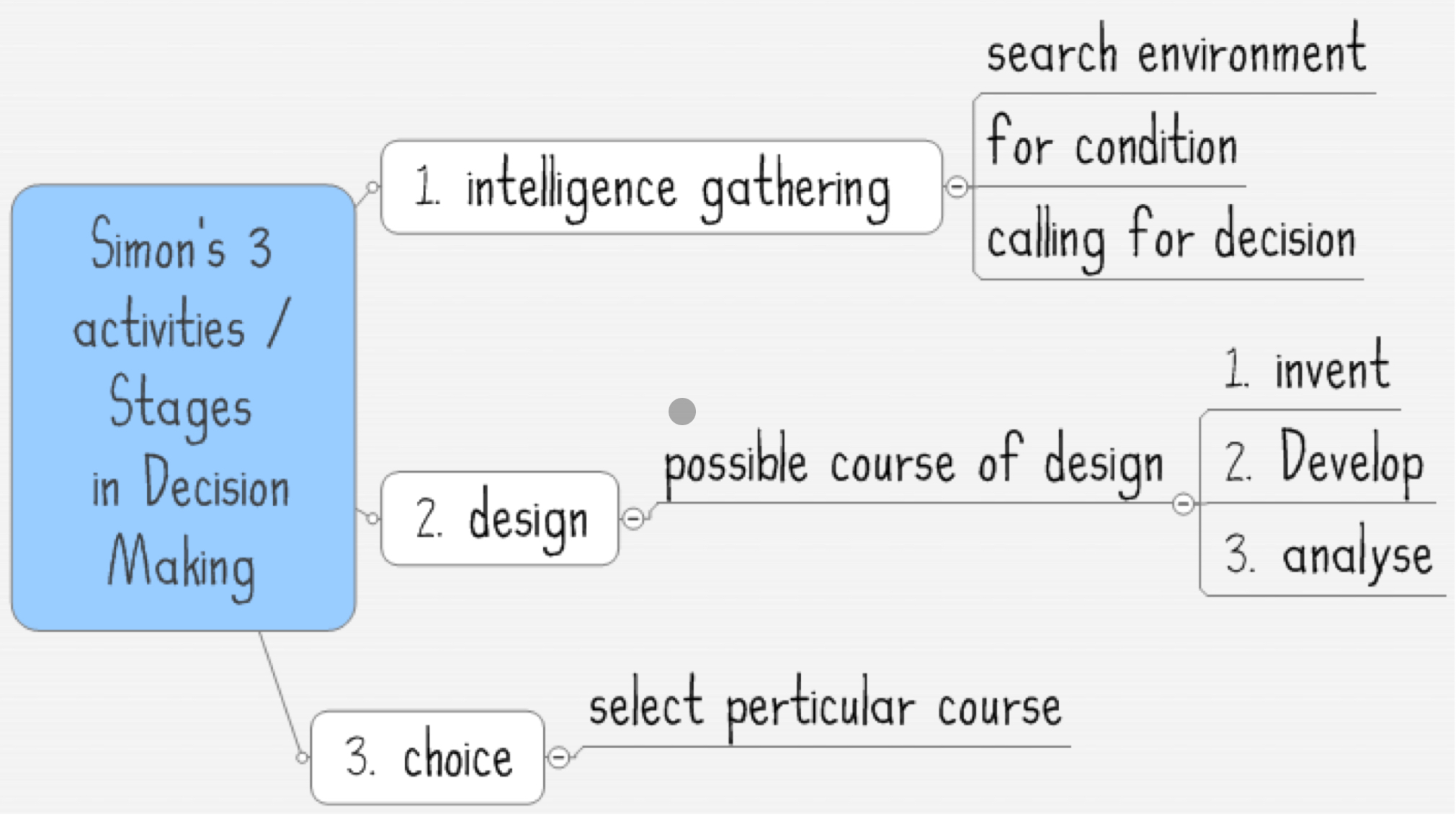
What is a problem?
A problem is a situation where there is a gap between the current state and the desired state, and the path to the desired state is not immediately clear.
→ Problem is not lack of a solution
What is bounded rationality?
Bounded rationality suggests that individuals make decisions based on the information they have available and are able to process, rather than considering all possible options.
→ People are only partly rational and are irrational in the remaining part of their actions.
→ People do not maximize utility
What does the problem-solving process look like for advisory services?
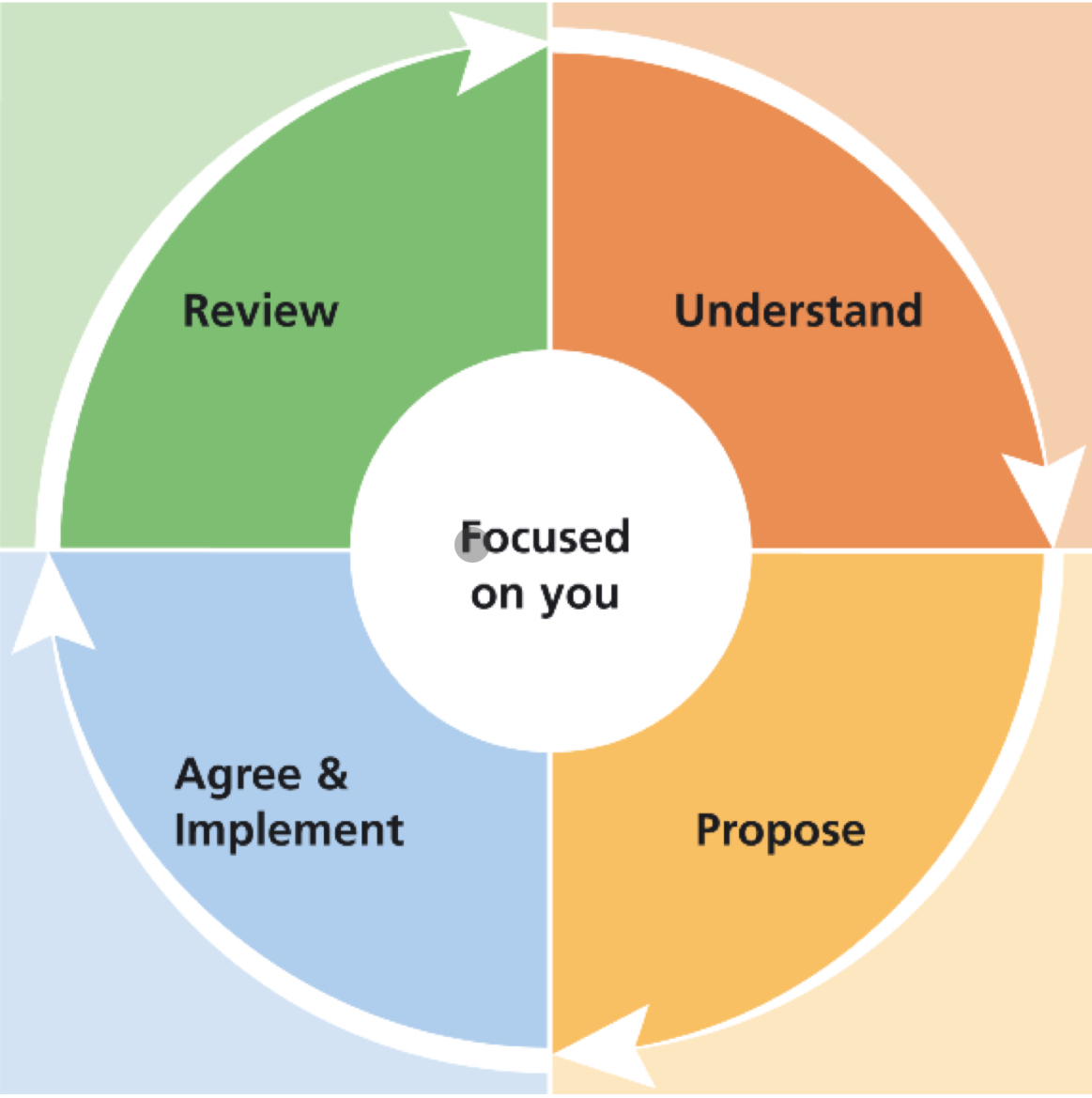
What are the benefits of large displays compared to tabletops?

What are requirements for collaborating on one display and how would collaboration look like?
Requirements:
– Support a flexible variety of coupling styles.
– Provide fluid transitions between coupling styles
– Provide personal territories
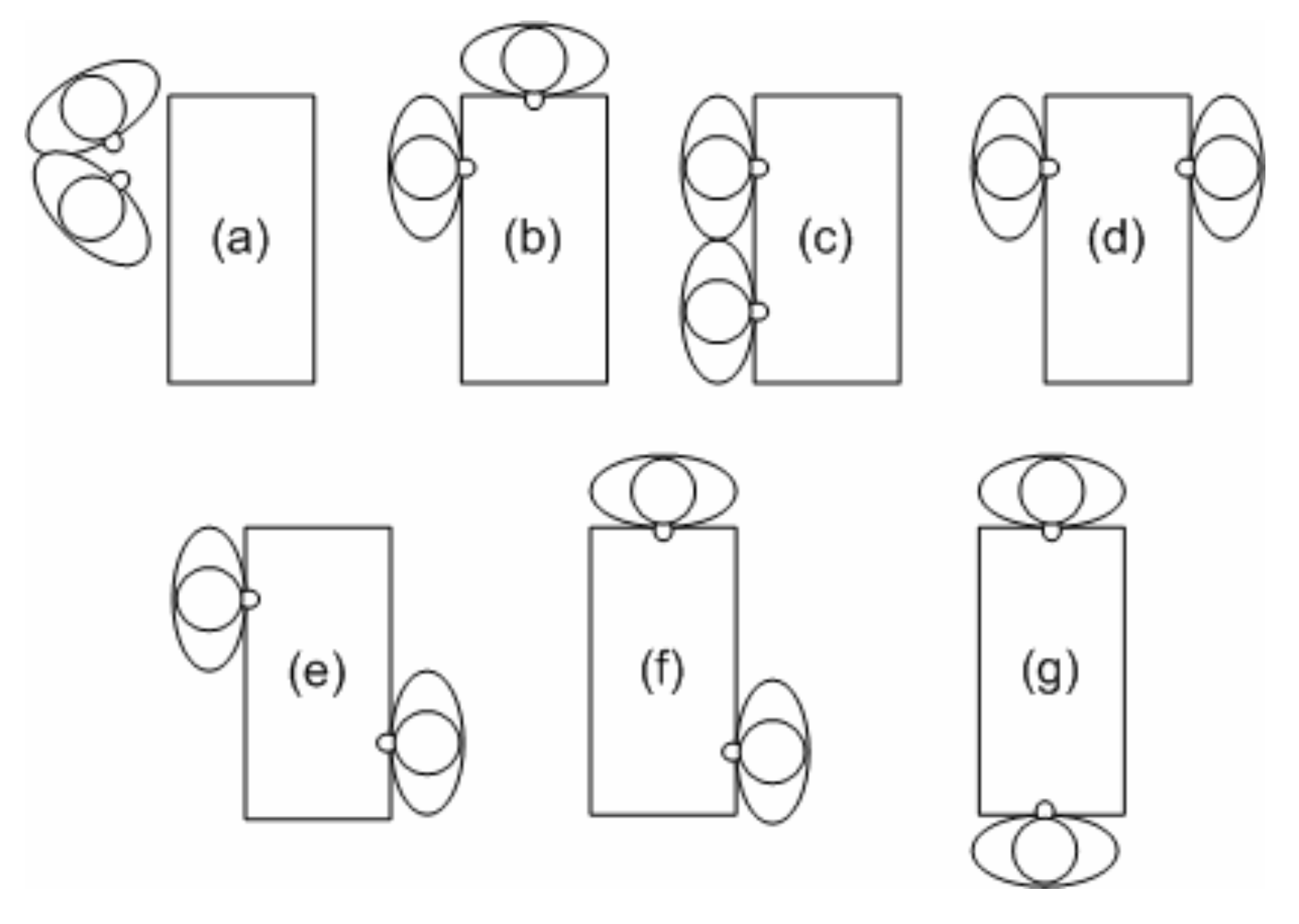
What are design principles for Single Display Groupware (SDG)?

What is artifact work space and relationship building space?

How useful is IT in knowledge transfer?
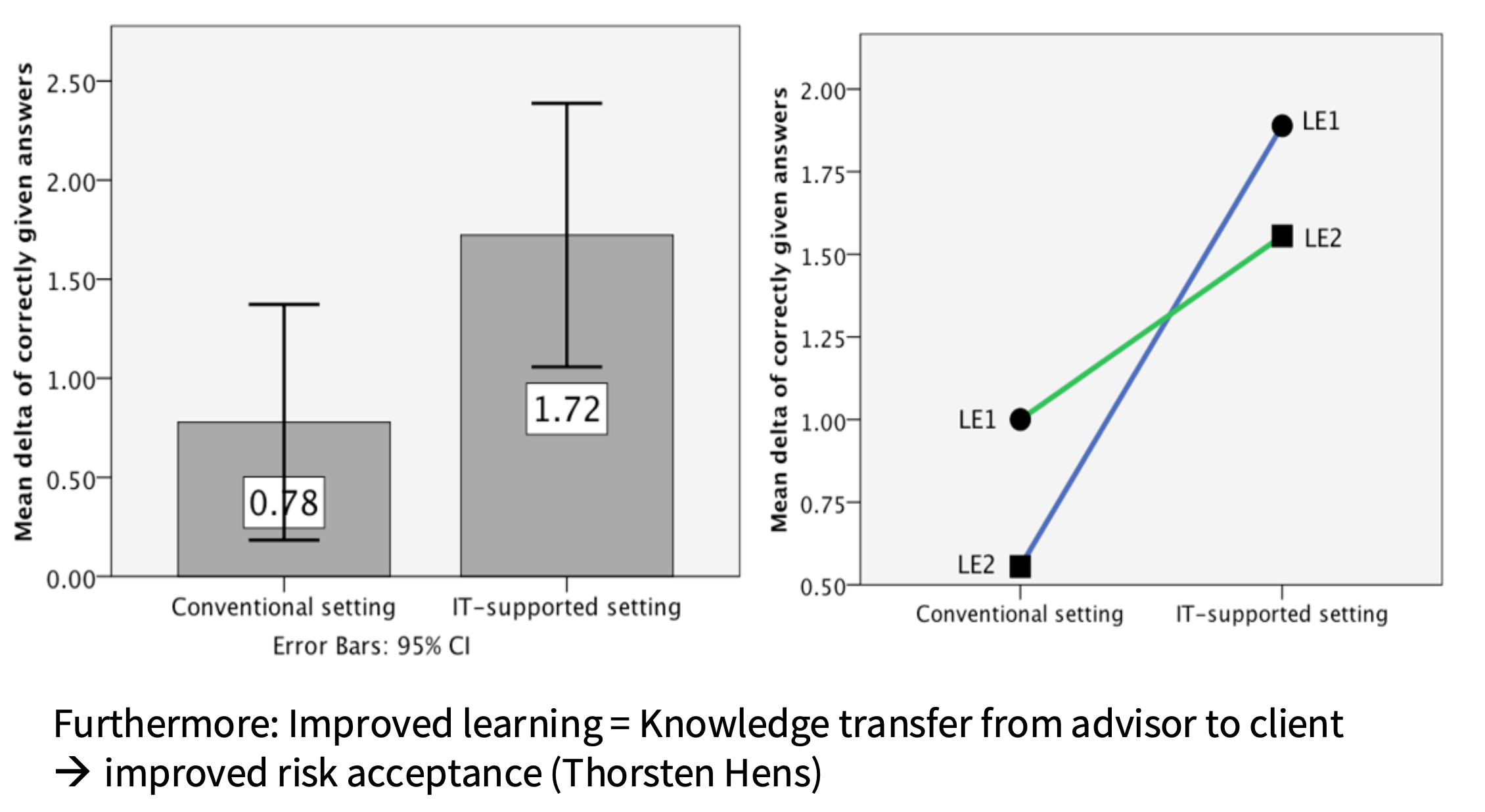
What is calm technology?
Interaction between the user and the technology occupies the user‘s periphery rather than being at the center of attention.
What is a tangible interface?
The user interacts with the technology through manipulation of the physical environment and elements in it.
Why might conversational agents have an anthropomorphic (human-like) design?
To trigger social responses, like trust, competence, joy, compassion, etc.
What is the uncanny valley?

What are command-based interactions and conversational interactions?
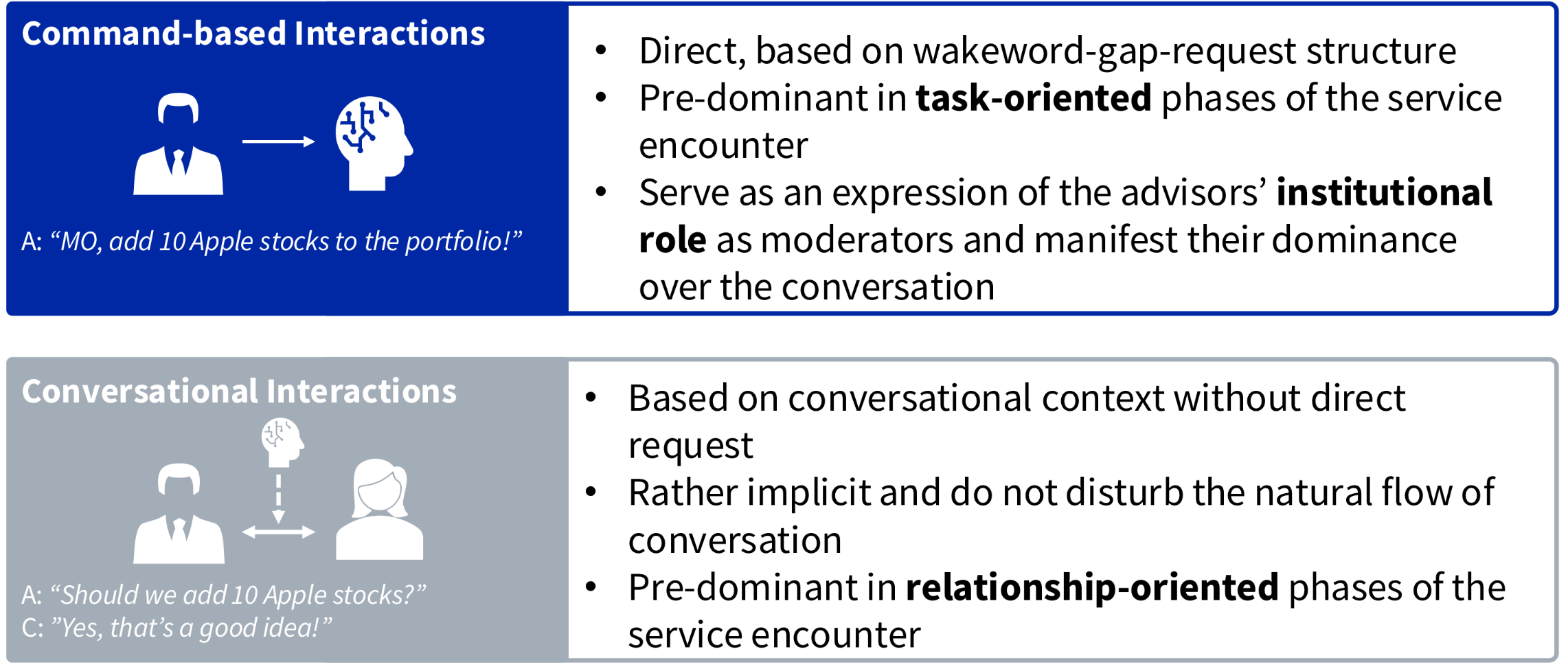
What is the primary and the secondary mental model?
The primary mental model is the mental model of the primary user (advisor), and the secondary mental model is the mental model of the secondary user (client).
What are the design requirements for the investment advisory support system?
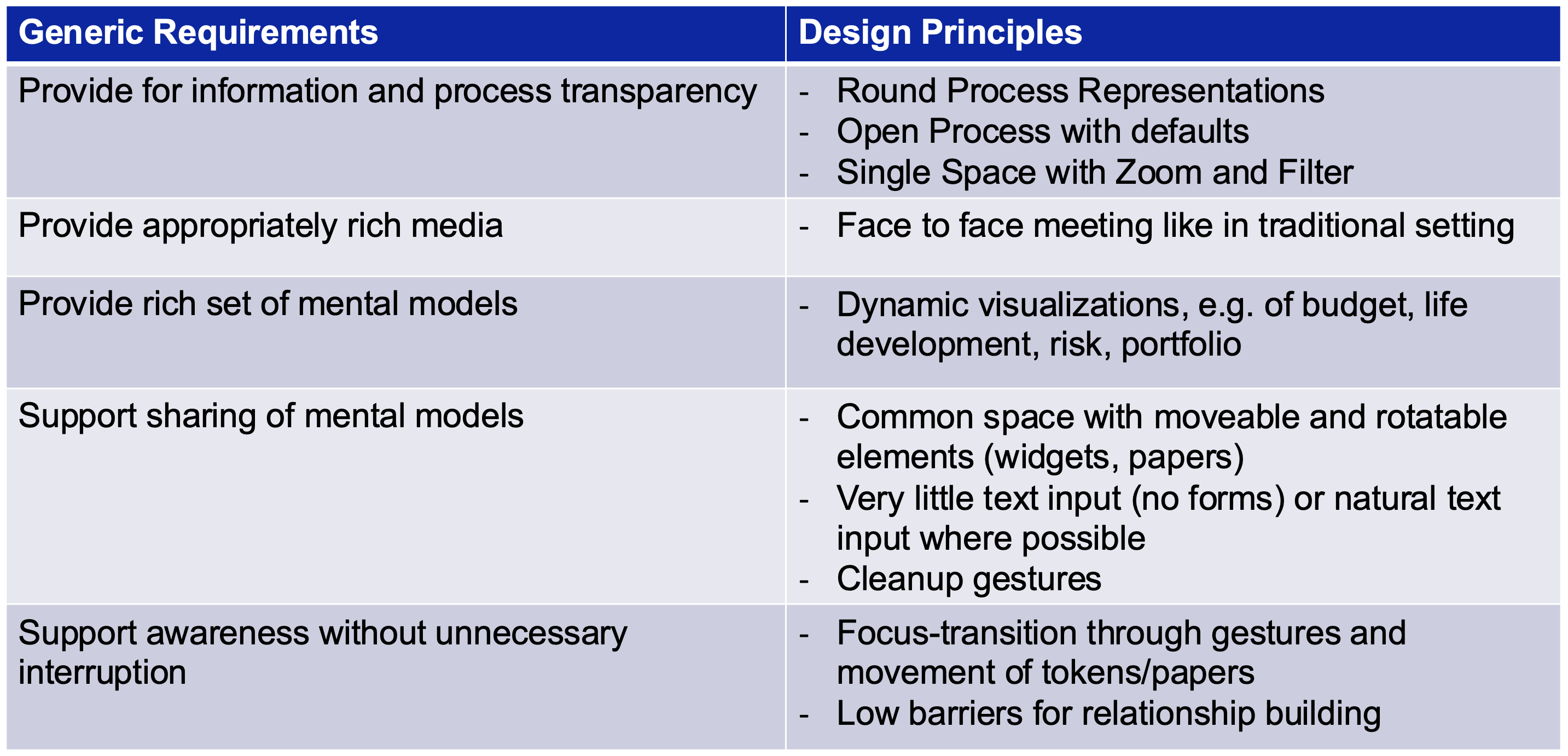
What is persuasion?
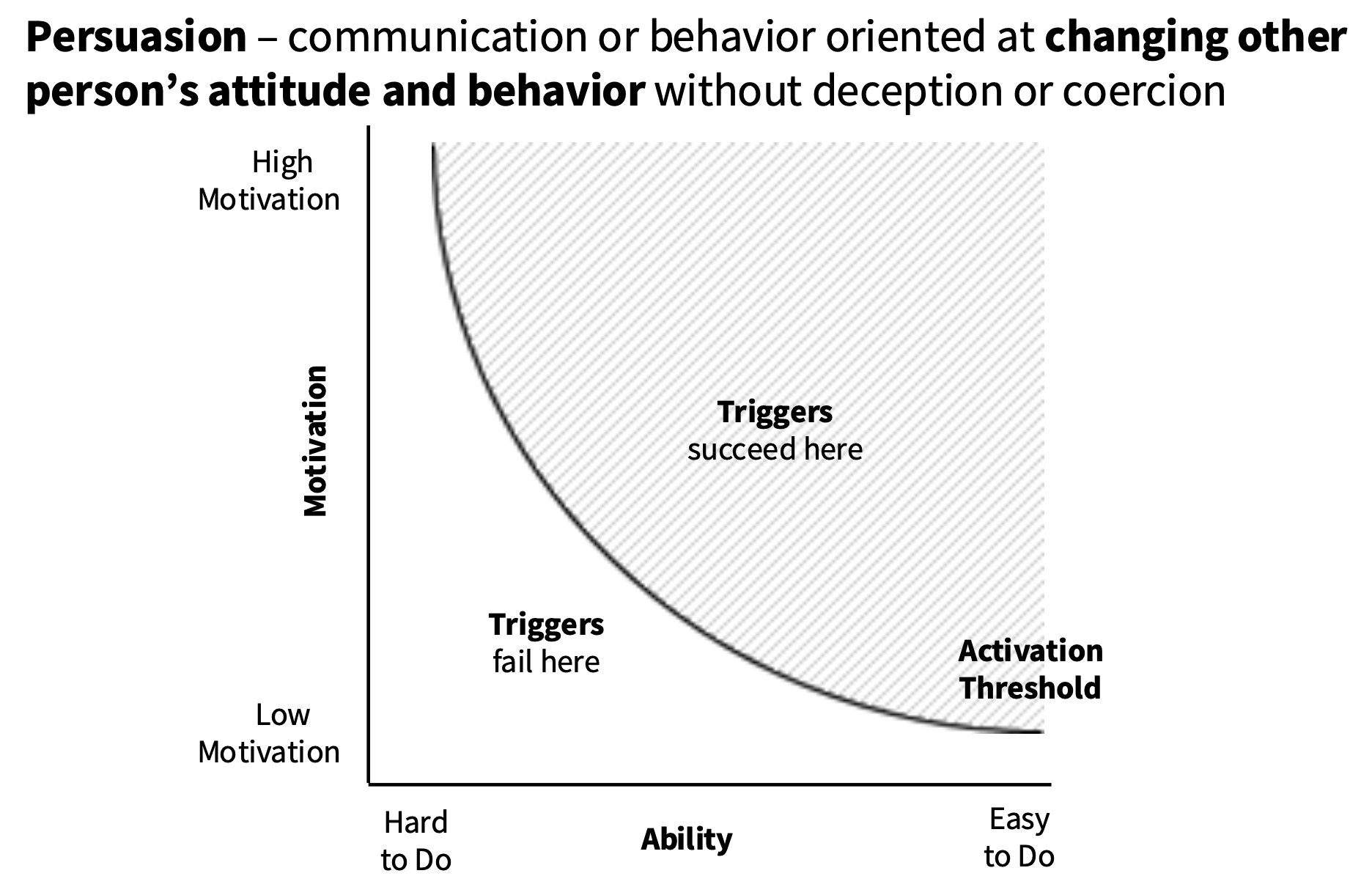
What are persuasive practices?
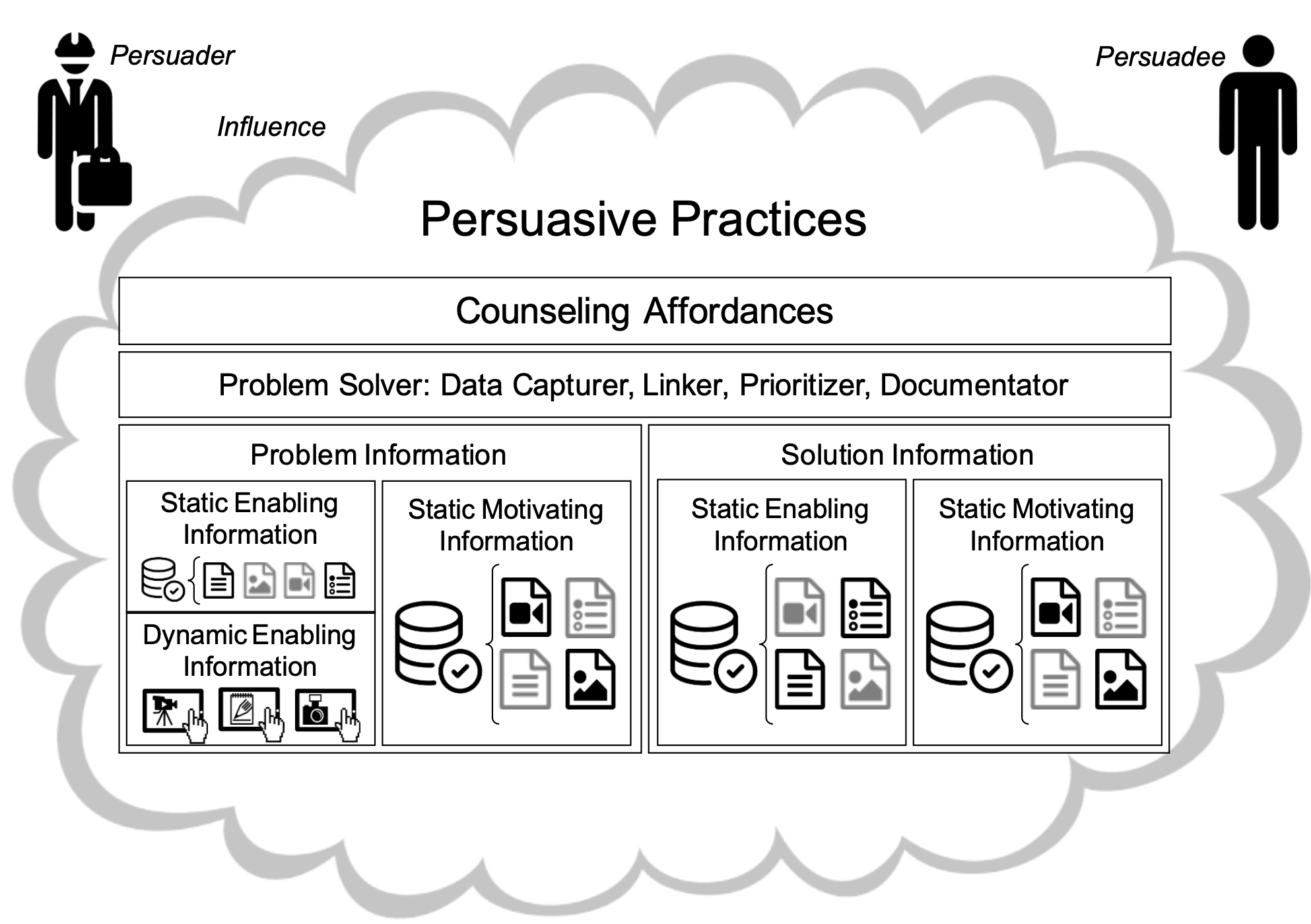
What are the three different views on advisory services?

What are the design requirements for the mobile crime prevention counseling?
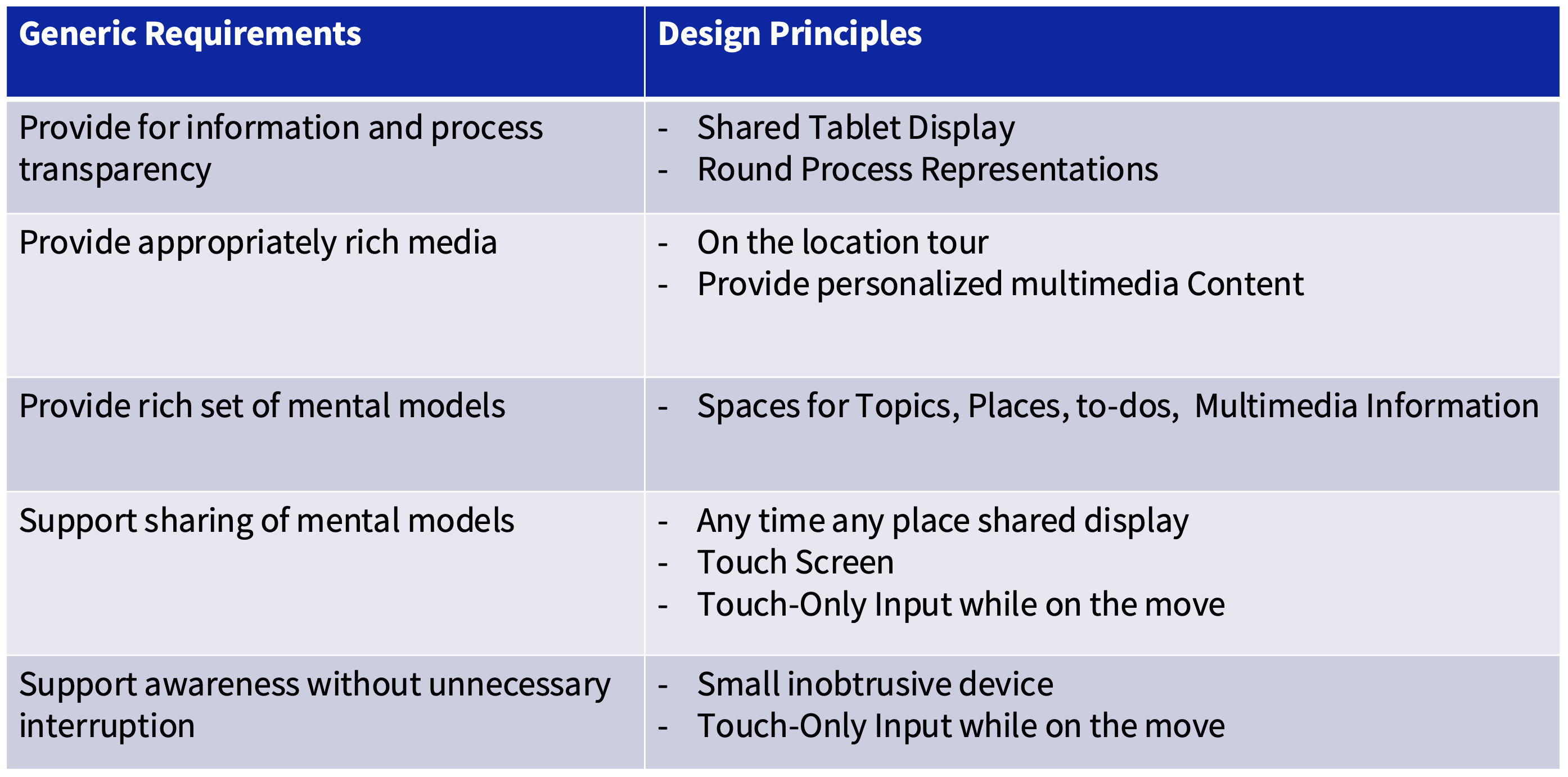
What are the 3 digital agents in the digital companion for patients at home?
Health Literacy Agent:
– Contains treatment plan and patient profile
– Creates medical documentation in lay language
Adherence Agent:
– Evaluates adherence based on treatment plan and
adherence measurement
– Initiates adherence support
Conversation Agent:
– Interacts with patient to
– gather data for adherence measurement
– advice patient
– inform patient
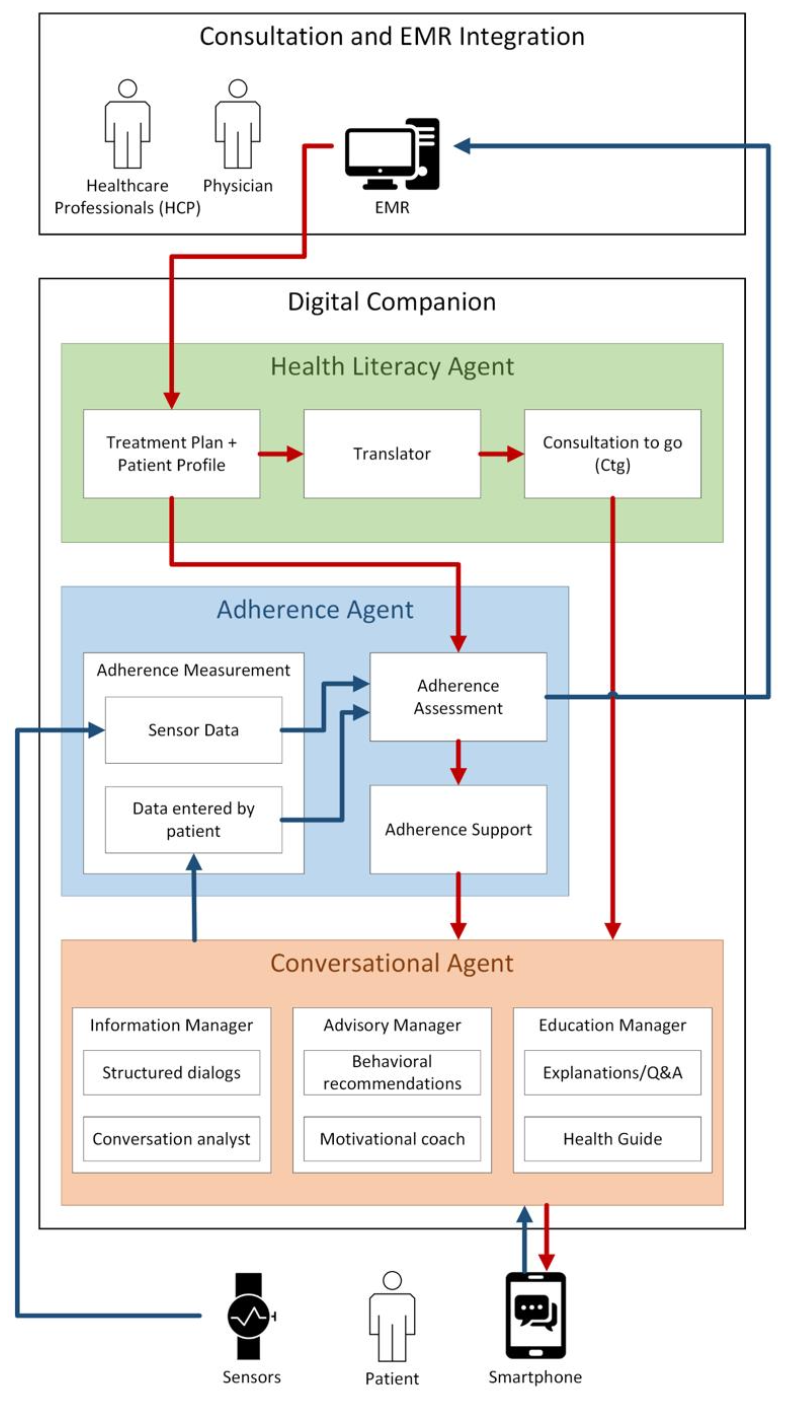
What is the PROMISE Framework for conversational agents?

What are characteristics of small groups?
– Typically, 3-5 persons working on a shared outcome (often in a project → project management)
– Good knowledge of one another
– Improvising process
– Can work in a face-to-face and distributed manner
– Rarer than individual work or dyadic collaboration
What are group work effects and problems?
Free-rider-effect: Some benefit from the work without contributing to it. The work is done by those group members, for whom it is important to achieve a good result.
Succer-effect: the group members, who do the most work, get angry and lose their motivation
Scissors-effect: people with higher motivation and better qualifications take over the main work, because for them contributions of other group members are not good enough or they are too slow.
Social loafing: The (unconscious) tendency to perform less with increasing group size, regardless of whether the task is interesting or meaningful.
Risky-shift phenomenon: tendency of groups to make riskier decisions than any individual
Group think: Groups with high cohesion tend to protect the group from contrary viewpoints and isolate themselves from outside criticism
What factors in a group influence individual behaviour?
Group size
– Dyads - triads - small groups - large groups
Group structure
– Dimensions: status, role, power, hierarchy
Composition of the group
– Similarities between members (socio-demographic characteristics: gender, denomination, etc.)
Spatial position of members
Communication structure
– Precondition and product of ongoing interaction
– Central/peripheral members
– Central/distributed groups
– Task execution: faster in centralized networks (star, line, tree) than in decentralized networks (ring, mesh, fully connected)
How do individuals influence group behaviour?
Relationship reciprocity
– A likes B → B likes A
Cognitive balancing
– Balanced relationship between A & B, when both have a positive or a negative relationship to the object
Categorical perception of persons is blurred
– Perception and appraisal of persons vary according to the context
Attribution
– People interpret actions by another person as a consequence of their intention
How are opinions formed in groups?
Theory of informal communication
– Conformity pressure and risk that non-conformity becomes an outsider
Exchange theory
– Conformity pressure may decrease under certain conditions (i.e. costs of conformity, etc.)
Social impact theory
– The higher the number of members of the majority opinion, the lower the influence of the minority opinion group
Theory of strong minorities
– Minorities may prevail under certain conditions (i.e. consistent argument, conviction of minority, etc.)
How can groups share physical space?
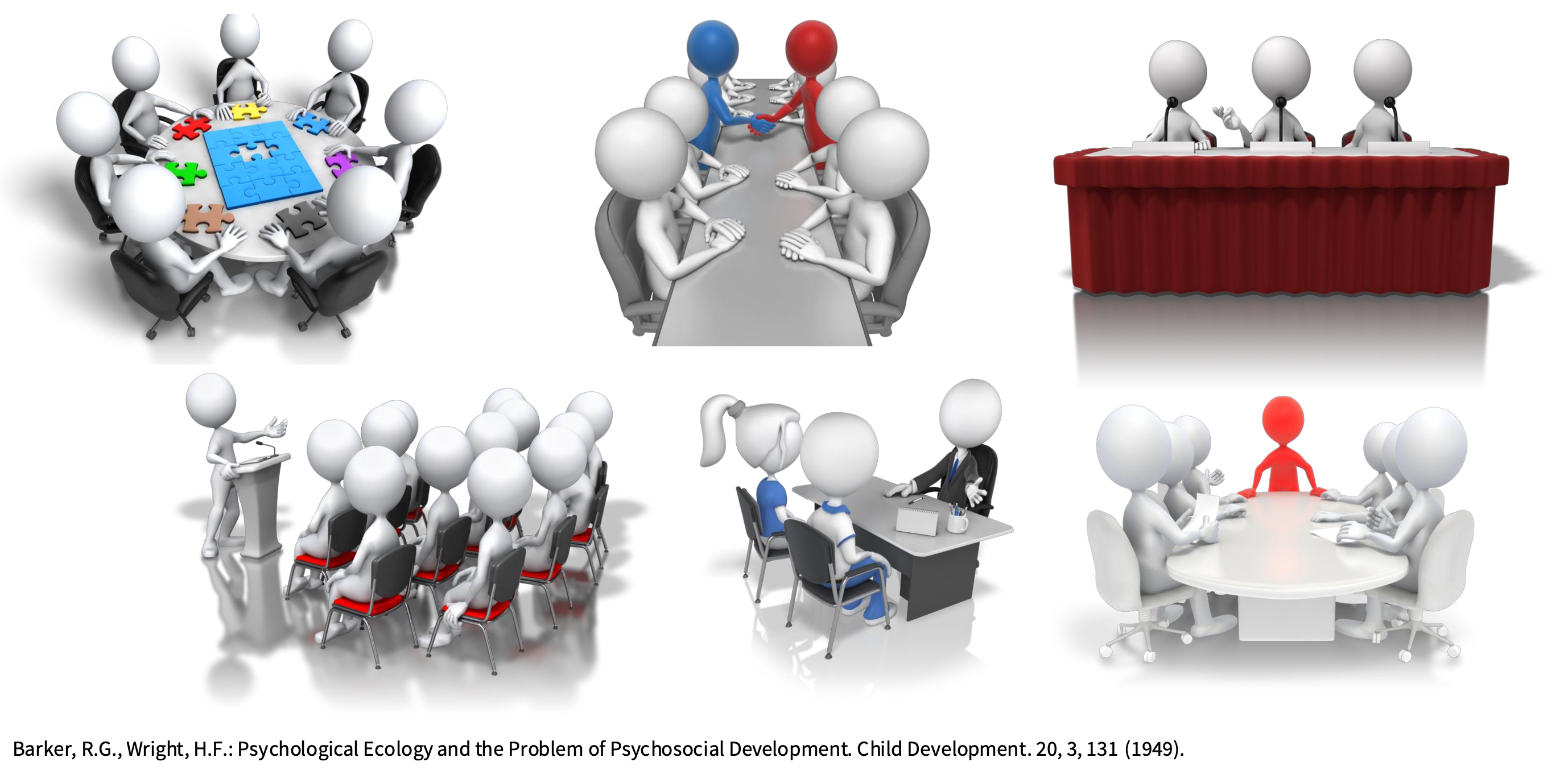
What are behavioral problems of small groups compared to dyads?
Most problems dyads have, small groups have, too
― Misunderstanding
Many problems become stronger
― Differences of interests
― Poor problem-solving approach
― Being aware of one another
Some problems are novel
― Group dynamics
What are the group work phases by Tuckman?
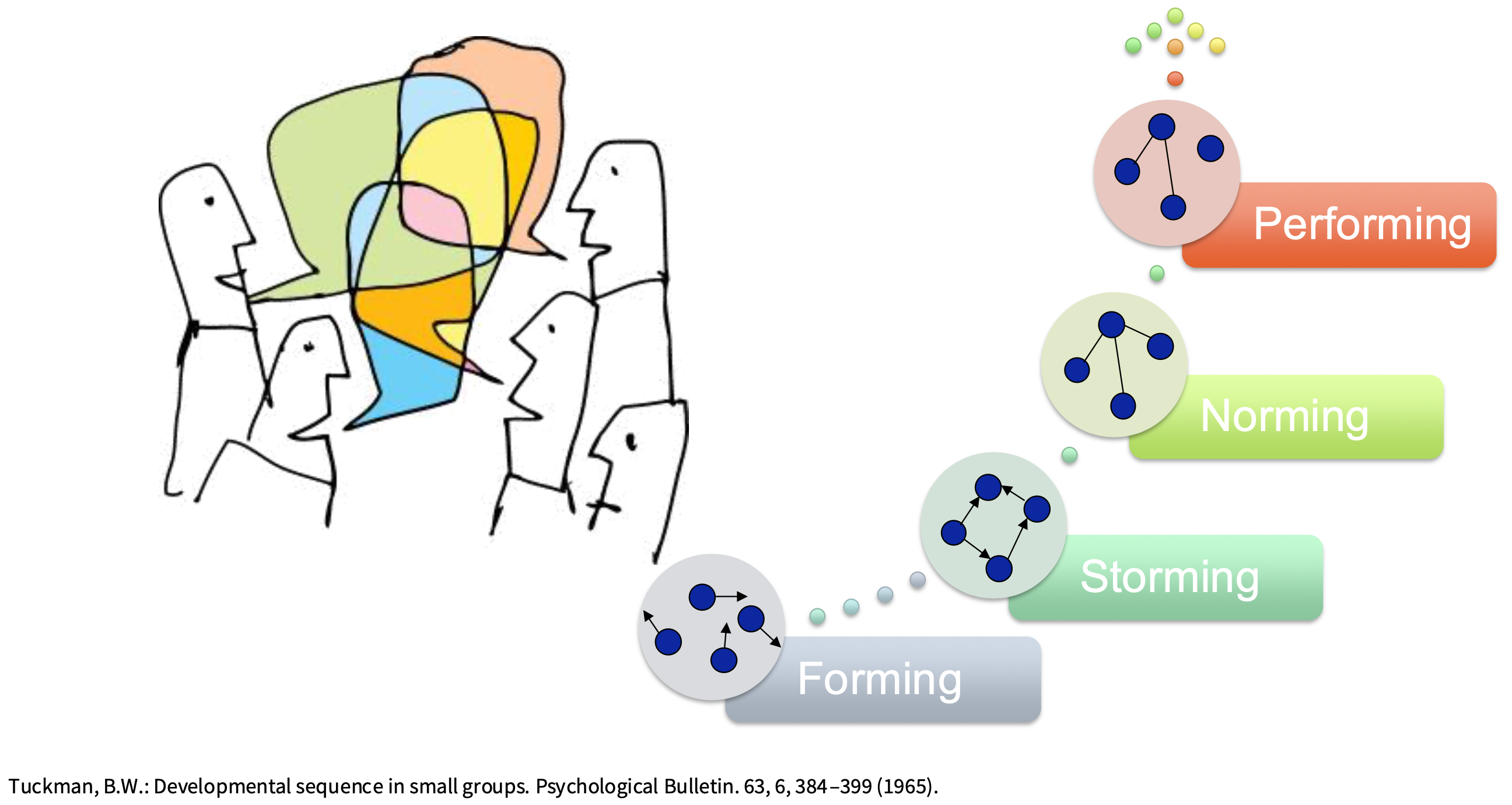
What is the TIP theory (time, interaction, performance)?

What are the three functions according to TIP theory?

What are the four modes according to TIP theory?
Mode I, Inception:
Goal attainment for the project, for the group and for the individual member.
This definitely happens at the beginning of the group life cycle, but can also occur in later phases, e.g. if tasks or group memberships are changing and therefore, the goals need to be reconsidered
Mode II, Technical Problem Solving:
Solution of everyday organizational and technical issues in the project, how the project should be carried out, who has what role and which persons take on which tasks.
This includes work techniques. Typically, this is the main interest of the group research.
Mode III, Conflict Resolution:
How can different values, preferences, compensation, tasks and interests be reconciled.
Mode IV, Execution:
The required activities to perform the task and to achieve the goals of the project, the group and the individuals.
This is the “real work” of the group.
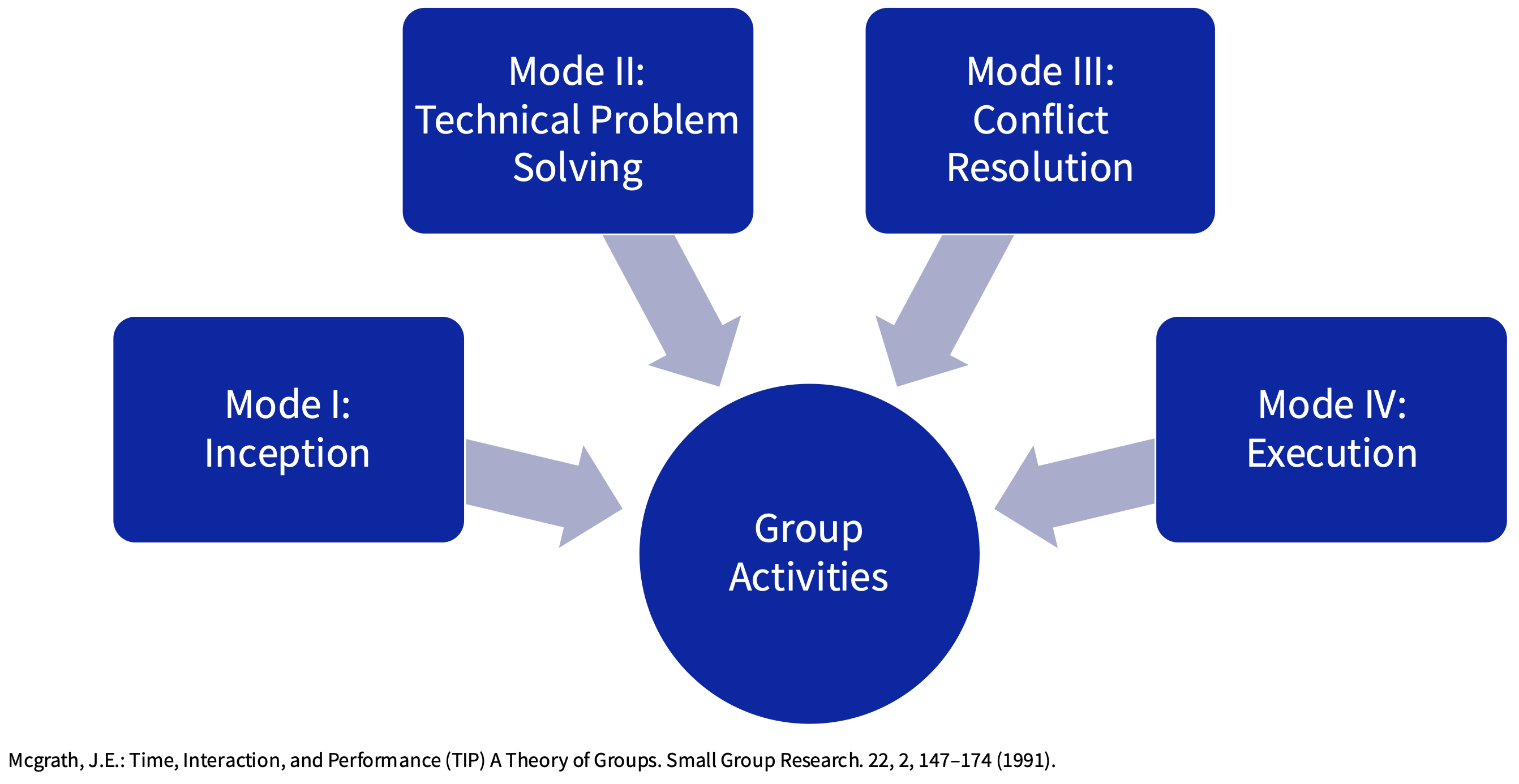
What is meant by “modes and functions are orthogonal to each other”?
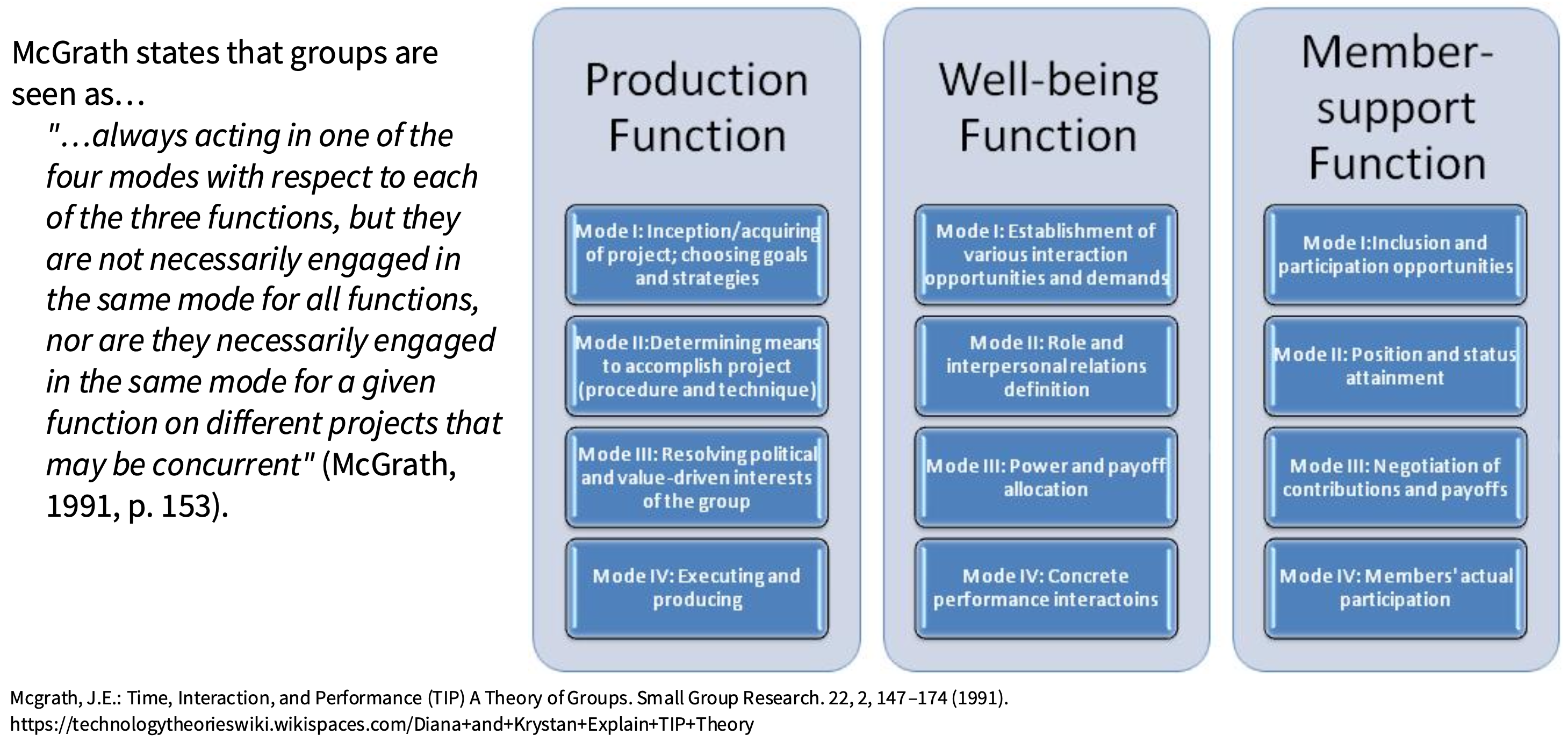
What does TIP-Theory mean for designing small group collaboration?
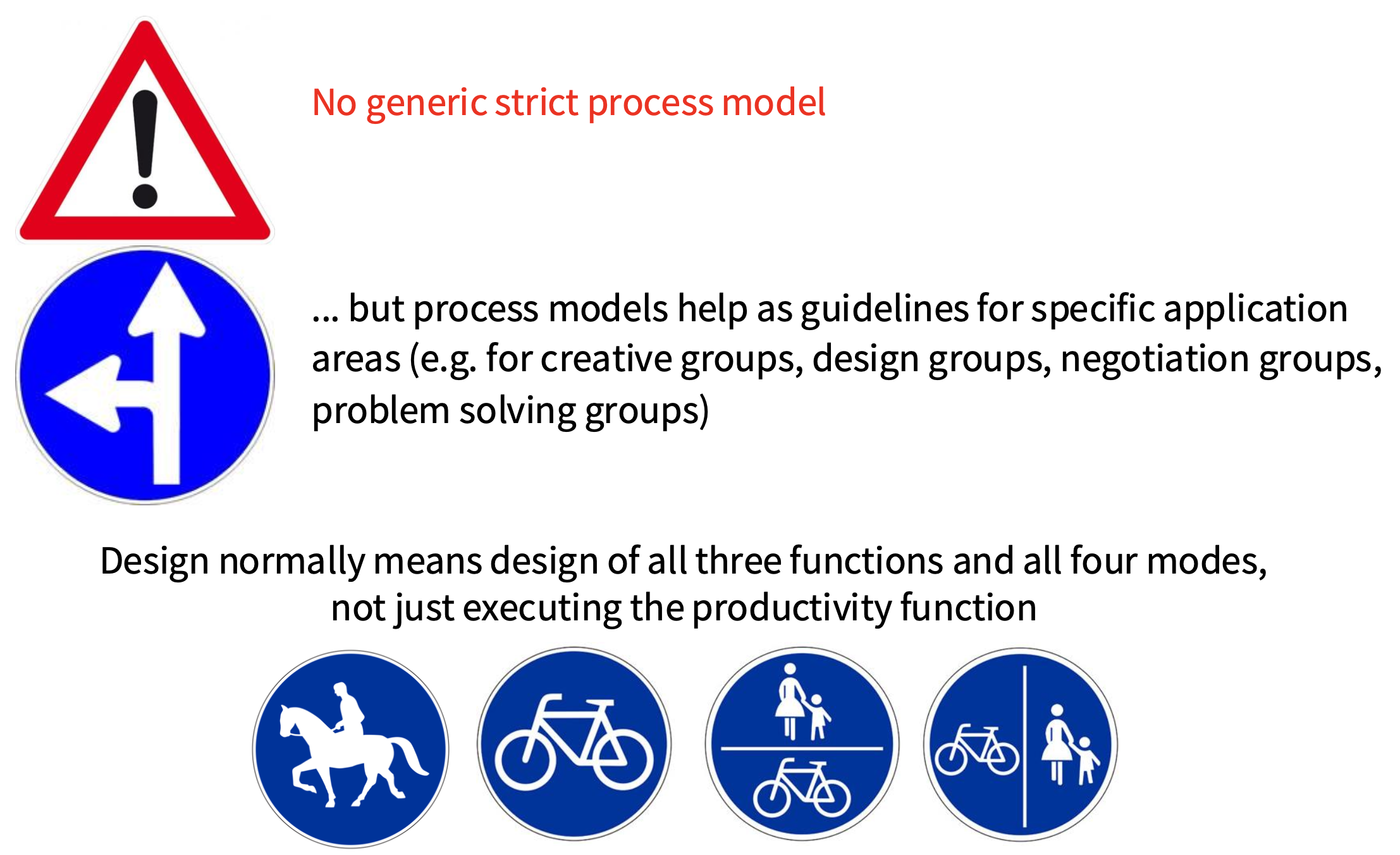
What is an IT tool?
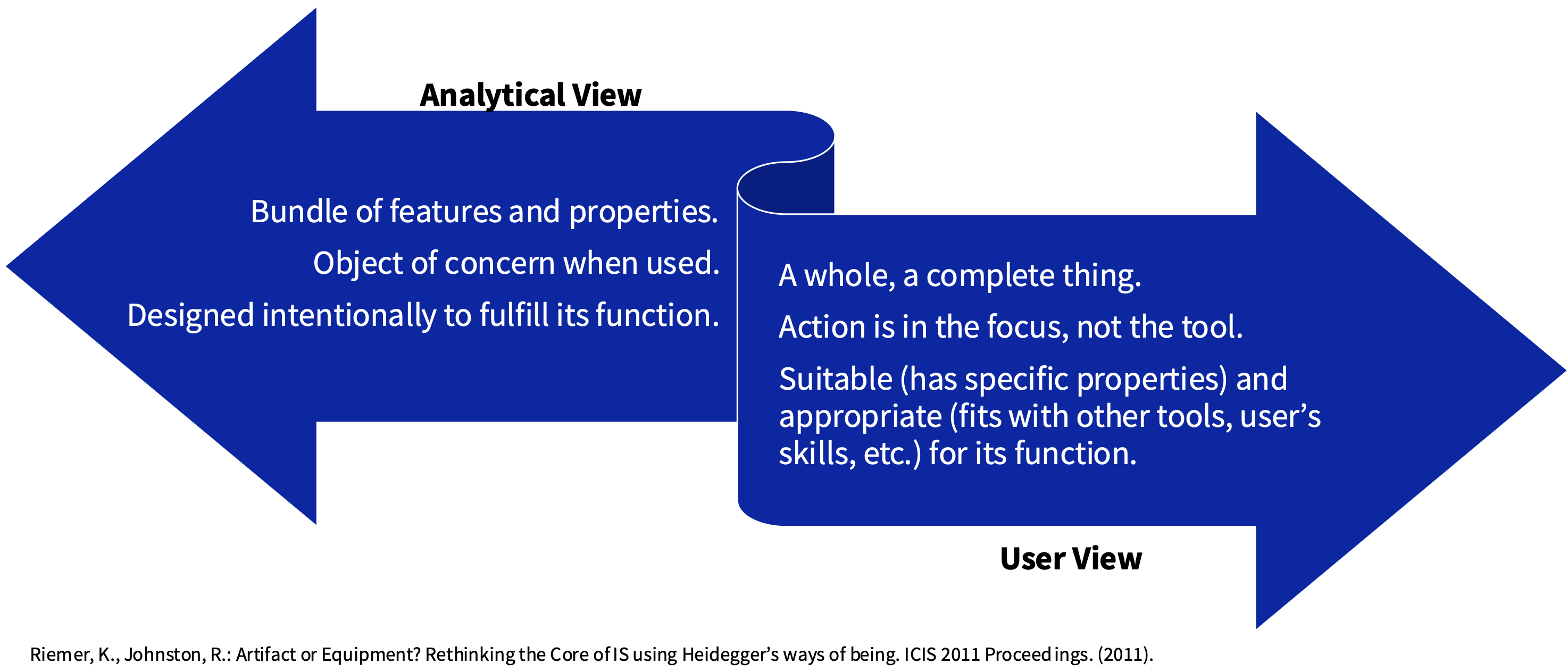
What are generic requirements for small groups (in addition to the requirements for dyads)?

What are examples of co-authoring and voting tools?
Collaborative text editor
Drawing tools (shared whiteboards)
Software design tools
Voting tools (e.g. voting or polling; in conferences or community forums)
Idea landscapes (e.g. cognitive maps, mind maps)
Shared screen, shared window and shared view
Virtual engineering (3D, CAD/CAVE)
What does WISIWYS stand for?
“What I See Is What You See”. This concept is used by many digital tools for small groups, where the view is the same for each participant, and only one person is controlling this view at a time.
What are generic requirements and design principles for shared viewing software?

What are pessimistic and optimistic methods for controlling user access in shared editing?
1. Pessimistic method
– Lock document
– Lock area/paragraph
– Lock line
– Lock characters
2. Optimistic method
Everybody as all access plus
a) Awareness
b) Rollback/versions
What are generic requirements and design principles for shared editing?

What are the benefits and disadvantages of the Dropbox shared workspace?
Very little additional effort
―no password
―no learning
―few roles
―optimistic control strategy
Seamless integration
Follow the free business model
On Amazon Servers
But:
―host servers are located in US
―Profile information are being transferred together with file transfer activities
What are generic requirements and design principles for shared workspaces?

What is awareness and why is it important for cooperation?
Awareness as a prerequisite for cooperation
“Awareness is an understanding of the activities of others, which provides a context for your own activities” (Dourish & Belotti 1992)
Mutual coordination with the help of information about:
― Ongoing activities
― Participating actors
― Shared artifacts
― Working environment
Awareness as group perception
― Information about presence and current state / context of other group members
What kinds of awareness exist?
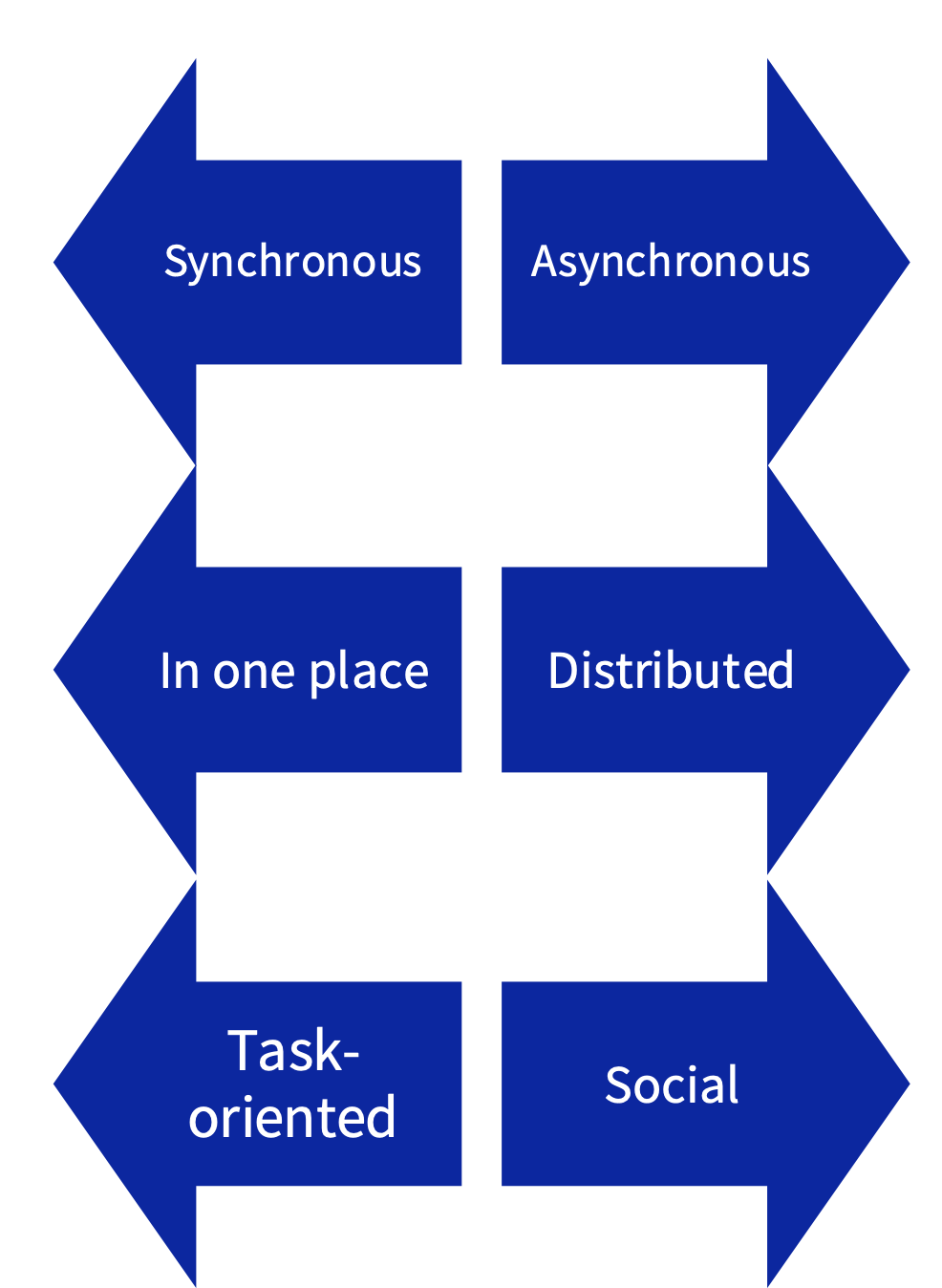
What is the orientation by event mechanism?
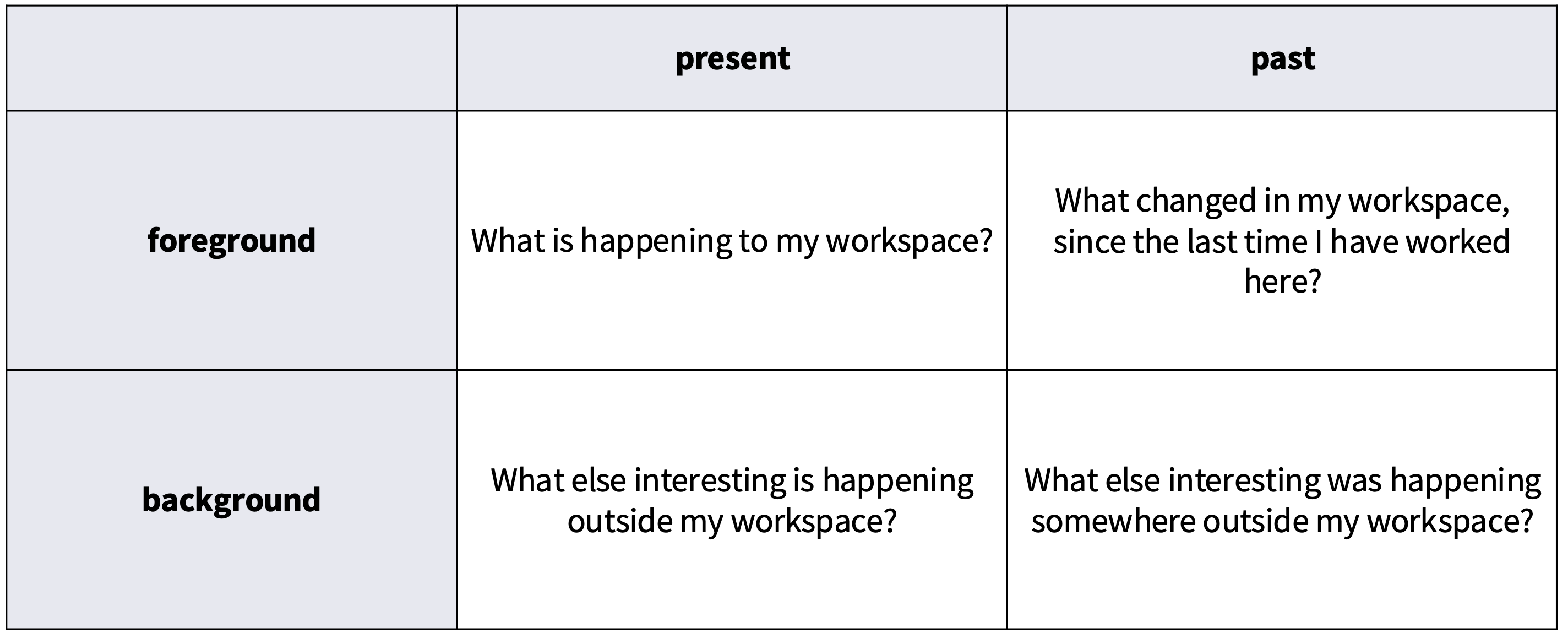
What are awareness architectures?
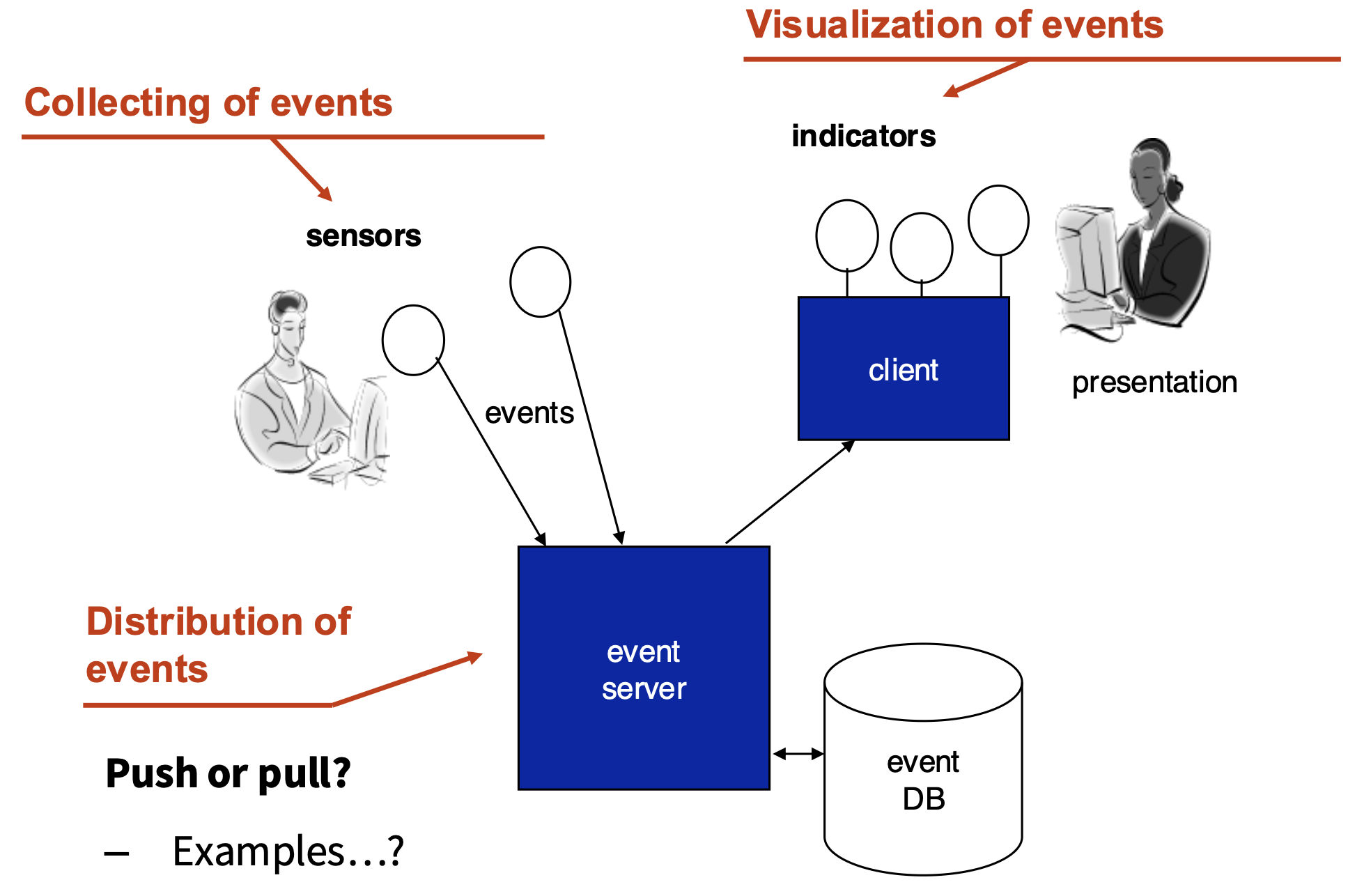
What is the awareness and privacy problem of control?

What is the awareness pipeline?

What are awareness models?
Event-based models: wave model
Propagation – events on an object propagate to other related objects
Decrease, threshold
Intensity: presentation and operation-dependent generation
Interest profiles – which events on which objects in which situation, the user wants to be informed
Space-based models
Calculate awareness between objects (people/artifacts)
Calculate automatically the areas of awareness
Medium, Aura, Focus, Nimbus
If Auras overlap → potential for interaction
The more an object is within your focus, the more aware you are of it.
The more an object is within your nimbus, the more aware it is of you.
Good for modeling synchronous awareness in systems into which spatial structures can be mapped
What are generic requirements and design principles of awareness?
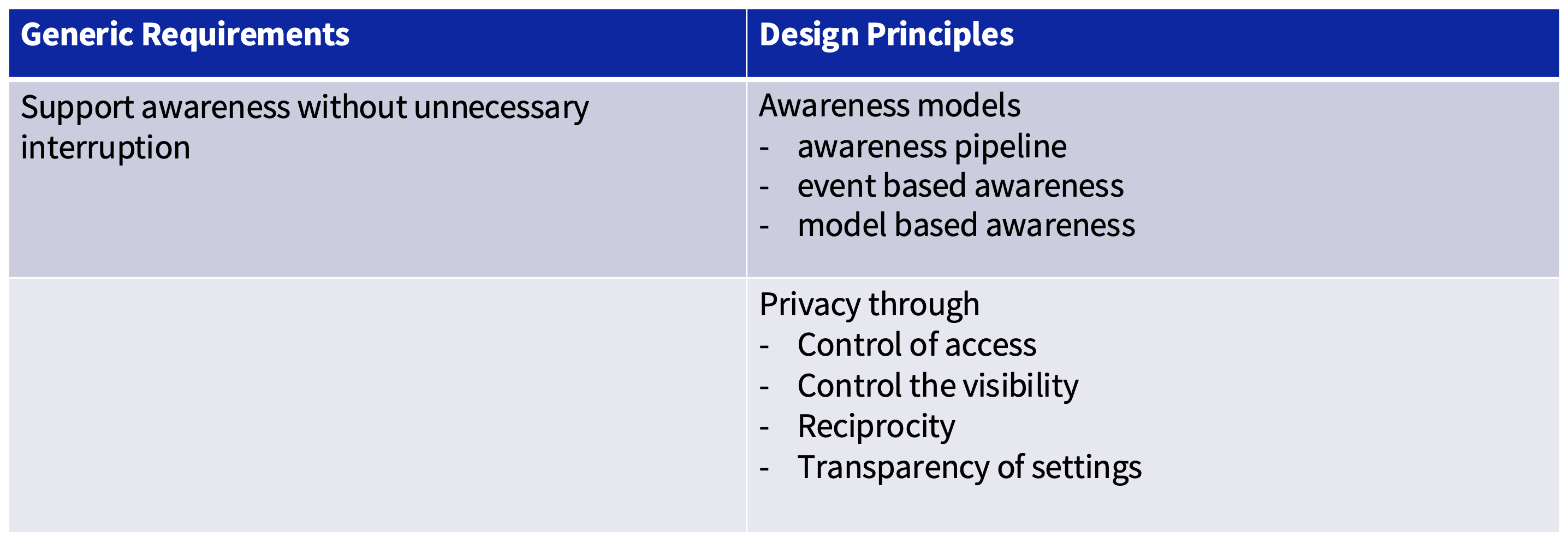
What are shared media spaces?
Media spaces:
– connect fixed locations such as office desktops,
– use continuous audio and video media,
– enable both awareness and communication by means of always-open channels.
What are generic requirements and design principles for shared media spaces?

What are generic requirements and design principles for communication?
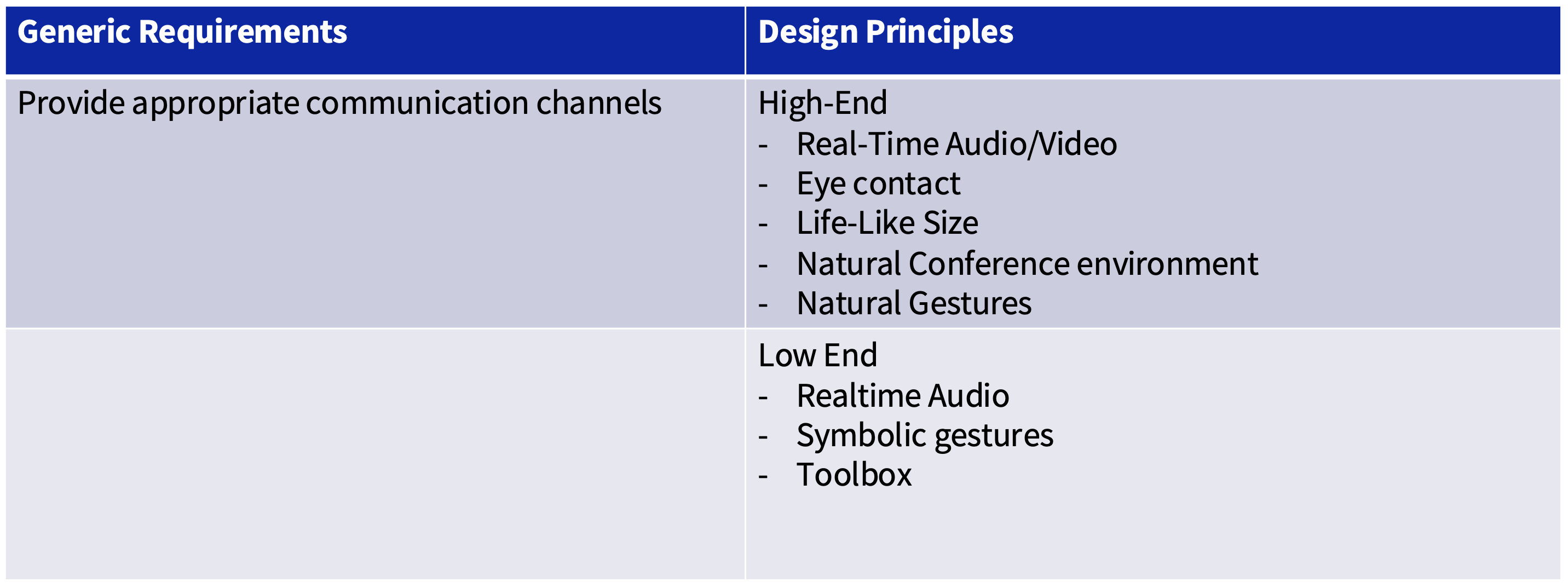
What are the differences between small groups and large groups?
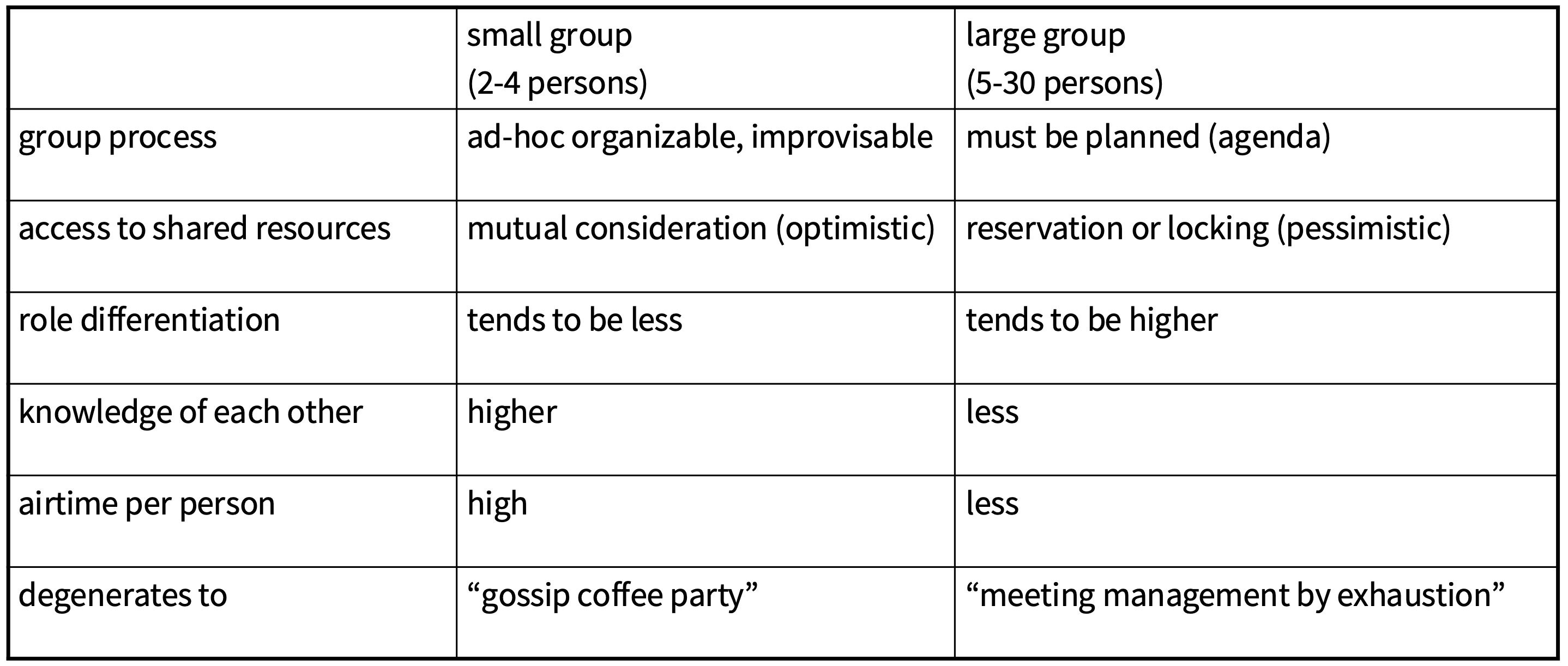
What are process losses and gains for large groups?

What is the theory of media synchronicity?
– The Theory of Media Synchronicity is a theory based on group facilitation techniques (Dennis, Fuller and Valacich, 2008):
– Synchronicity exists among individuals when they exhibit a shared pattern of coordinated synchronous behavior with a common focus.
– Media synchronicity is the extent to which the capabilities of a communication medium enable individuals to achieve synchronicity.
Synchronicity refers to the alignment of communication channels with the requirements of the task at hand. It focuses on the timing and coordination aspects of communication. Synchronous communication involves real-time interaction and immediate feedback between participants.
What are convergent and divergent communication processes?
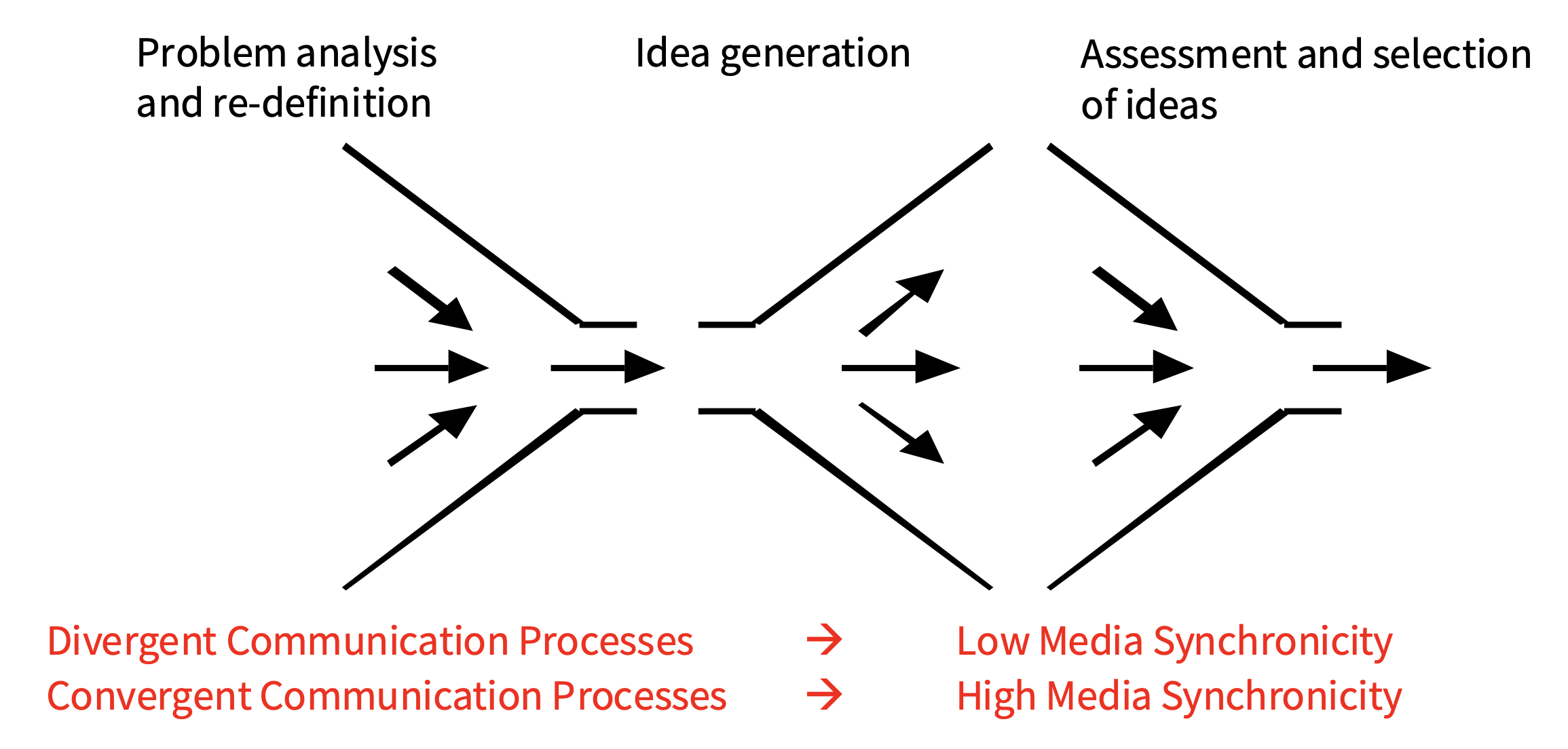

What is proposition 1?
P1: Communication performance will depend on the fit between a medium’s synchronicity and the fundamental communication processes being performed.
a. For communication processes in which convergence on meaning is the goal, use of higher synchronicity media will lead to better communication performance.
b. For communication processes in which the conveyance of information is the goal, use of lower synchronicity media will lead to better communication performance.
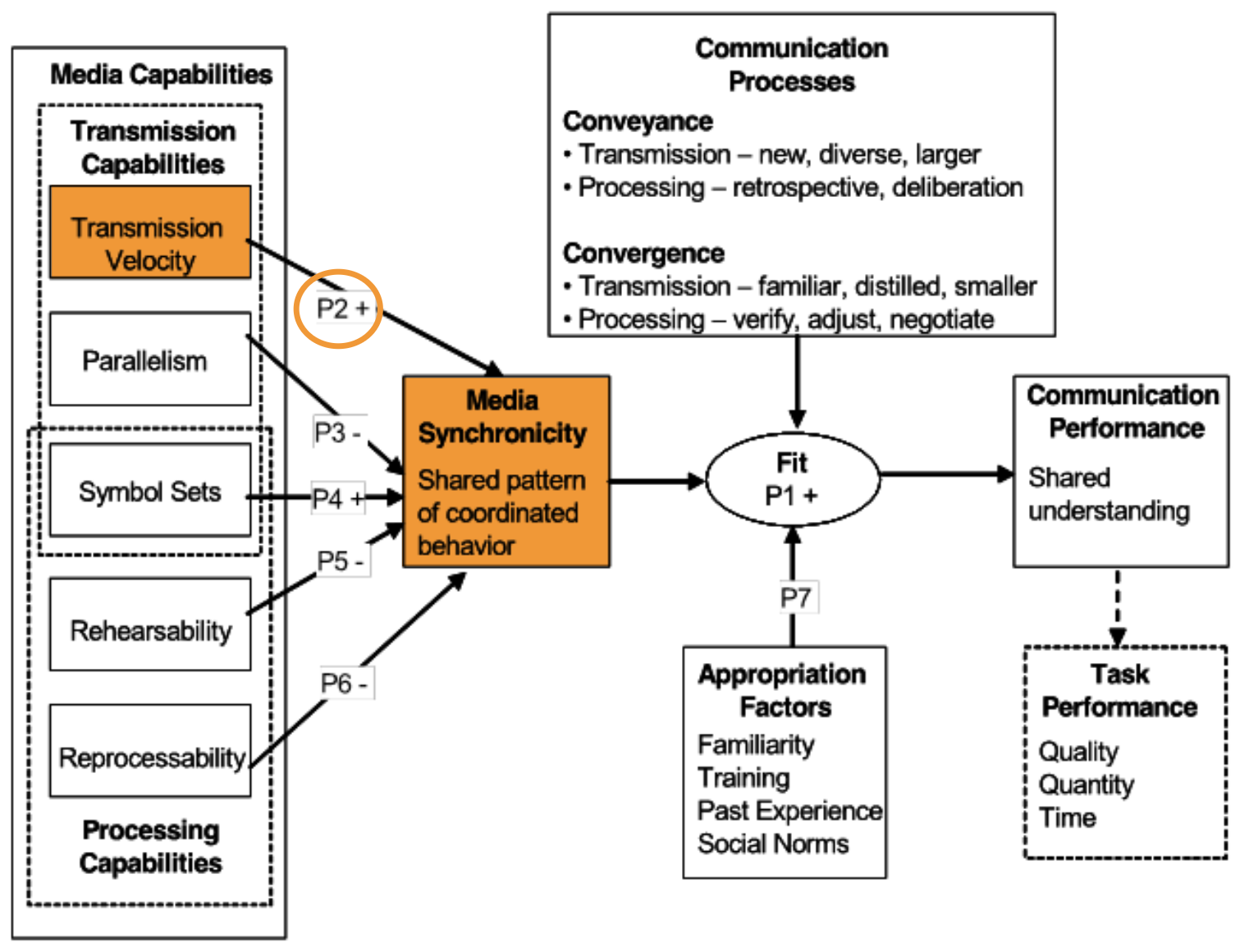
What is proposition 2?
P2: Transmission velocity improves shared focus which will have a positive impact on a medium’s capability to support synchronicity.
Transmission velocity is the speed at which a medium can deliver a message to intended recipients. Media that are high in transmission velocity allow messages to reach the recipients as soon as they are sent.
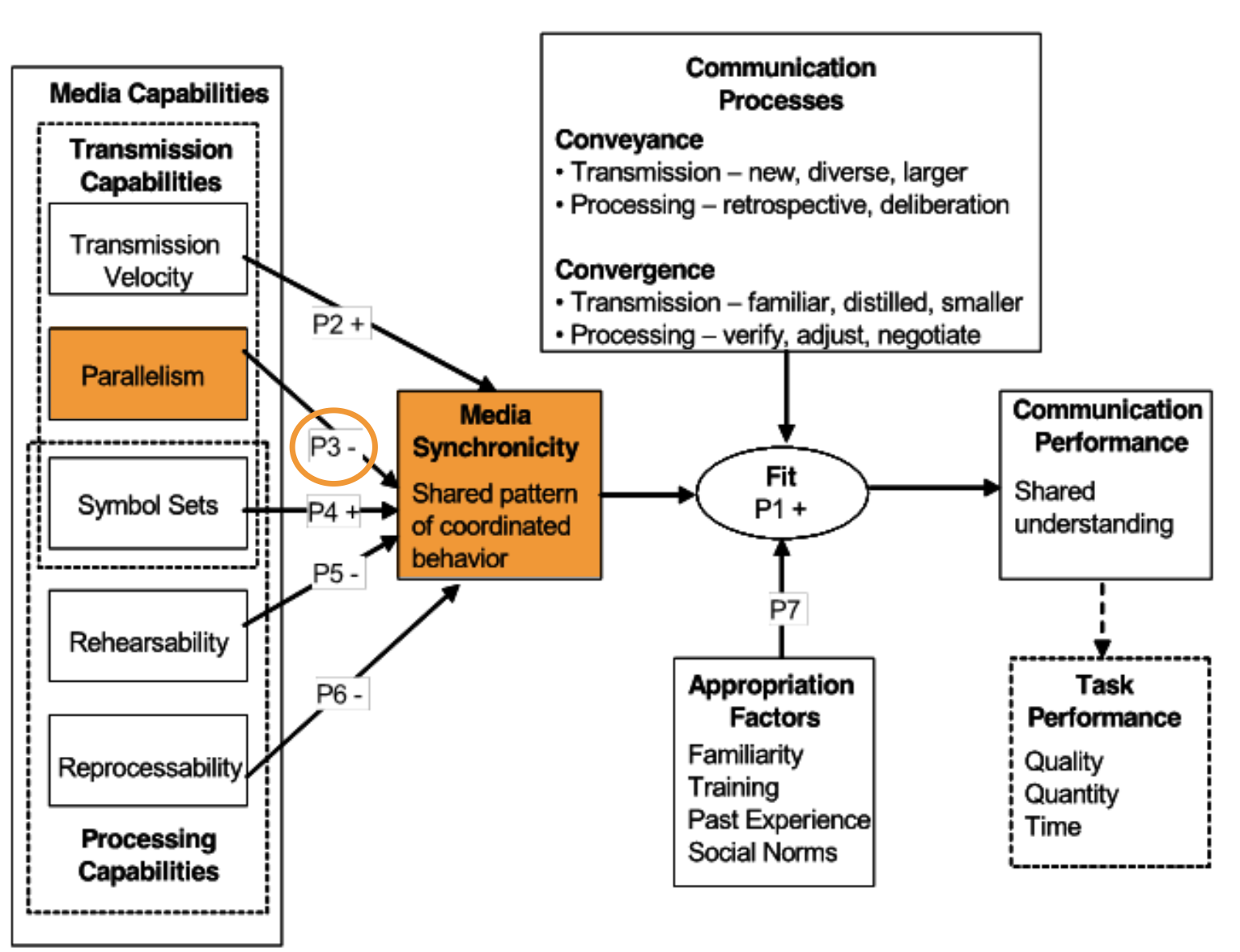
What is proposition 3?
P3: Parallelism lowers shared focus which will have a negative impact on a medium’s capability to support synchronicity.
Parallelism is the number of simultaneous transmissions that can effectively take place; it is the extent to which signals from multiple senders can be transmitted over the medium simultaneously.
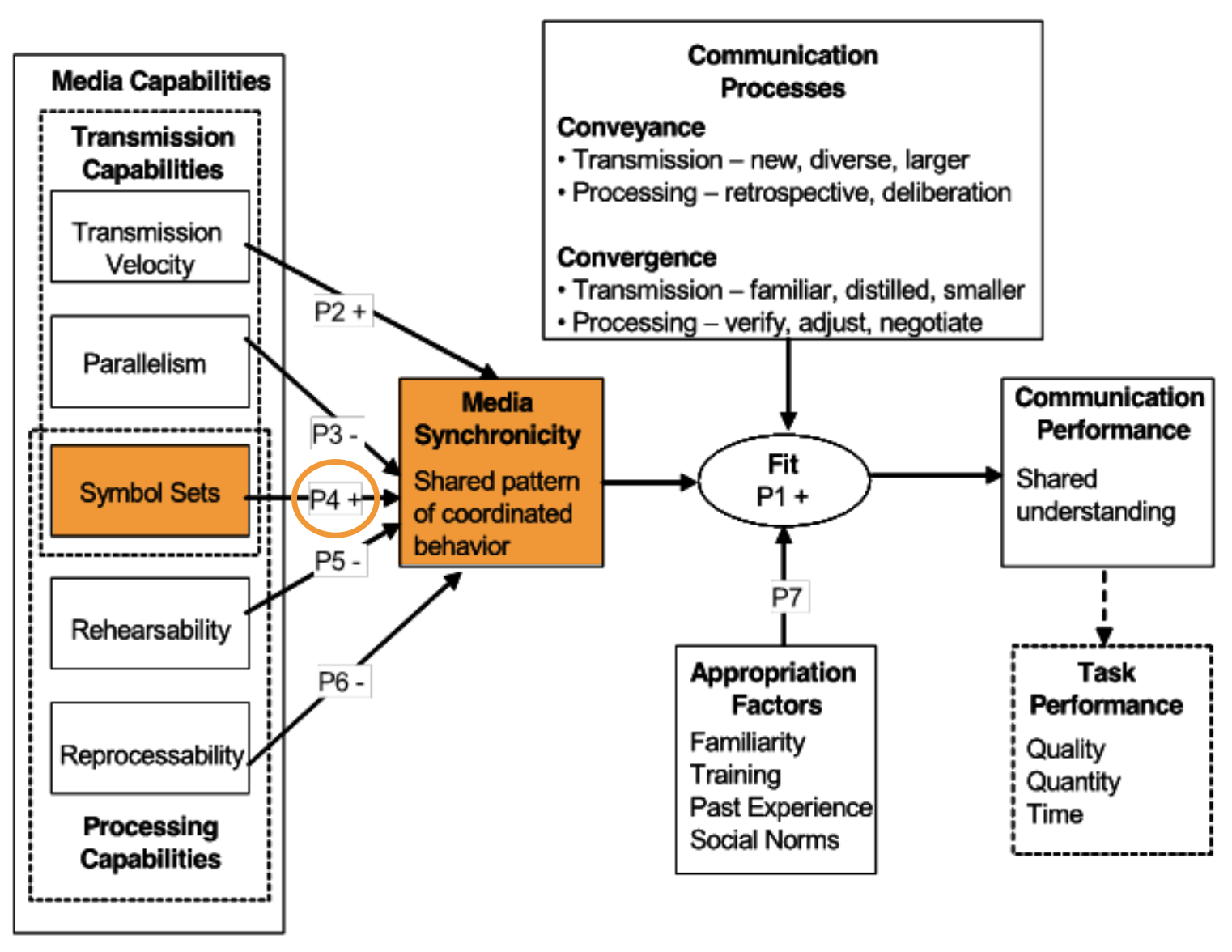
What is proposition 4?
P4: Symbol sets
a. Media with more natural symbol sets (physical, visual, and verbal) have a greater capability to support synchronicity as compared to media with less natural symbol sets (written or typed).
b. Using a medium with a symbol set better suited to the content of the message will improve information transmission and information processing, and therefore will have a greater capacity to support synchronicity.
Symbol sets are the number of ways in which a medium allows information to be encoded for communication; it subsumes multiplicity of cues and language variety.
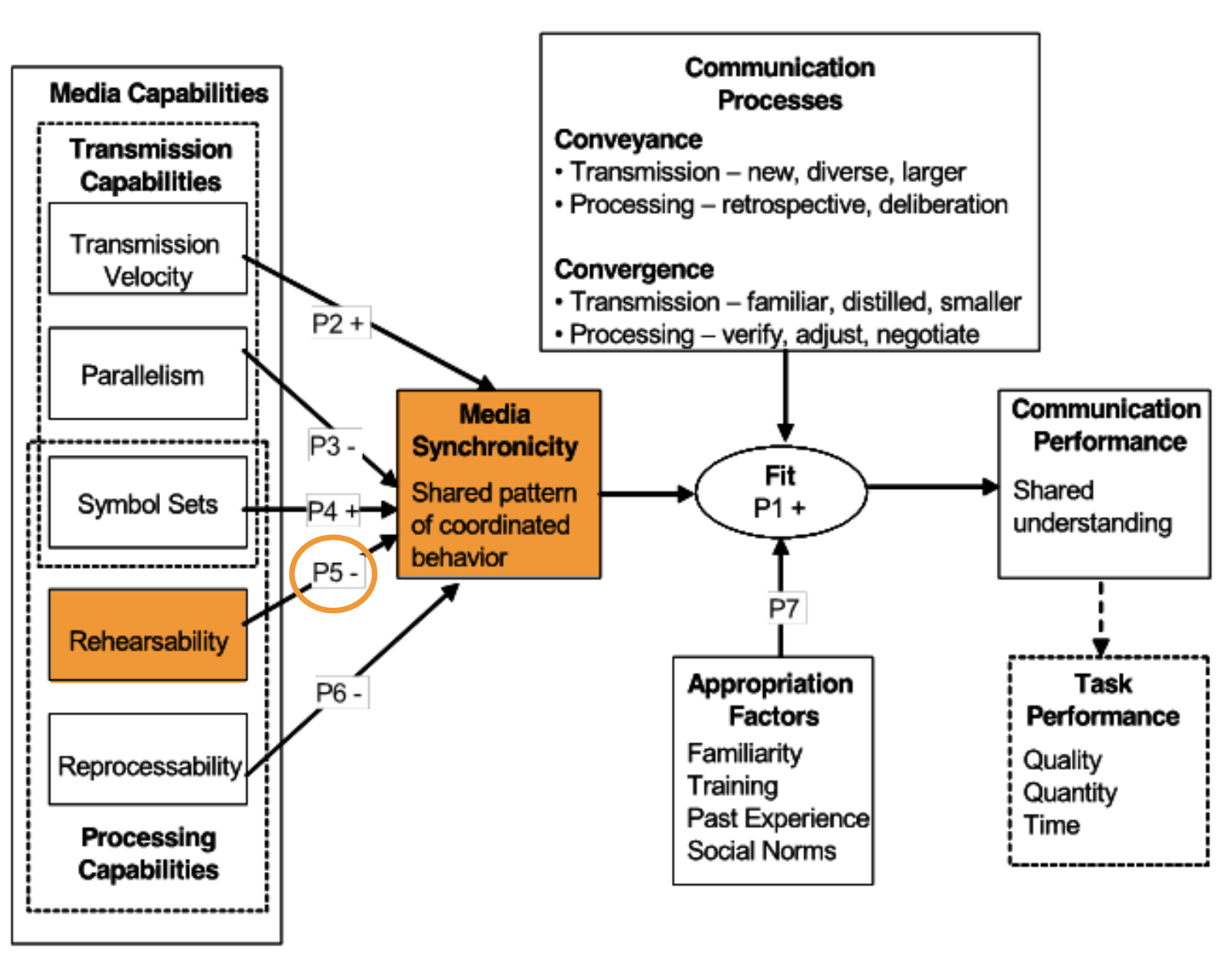
What is proposition 5?
P5: Rehearsability lowers shared focus, which will have a negative impact on a medium’s capability to support synchronicity.
Rehearsability is the extent to which the media enables the sender to rehearse or fine tune a message during encoding, before sending. It enables the sender to craft the message, but can create delays.
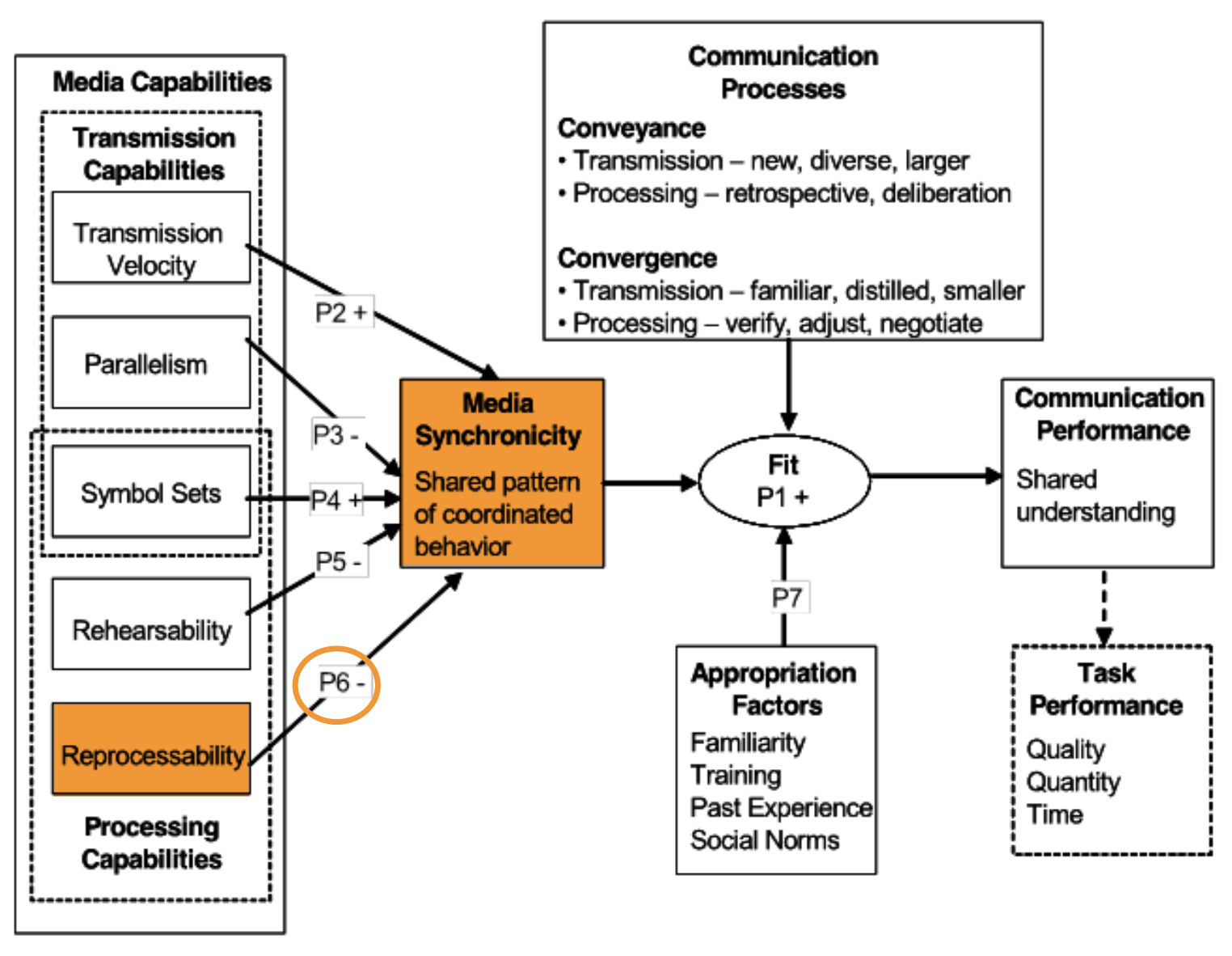
What is proposition 6?
P6: Reprocessability lowers shared focus, which will have a negative impact on a medium’s capability to support synchronicity.
Reprocessability is the extent to which the medium enables a message to be reexamined or processed again, during decoding, either within the context of the communication event or after the event.
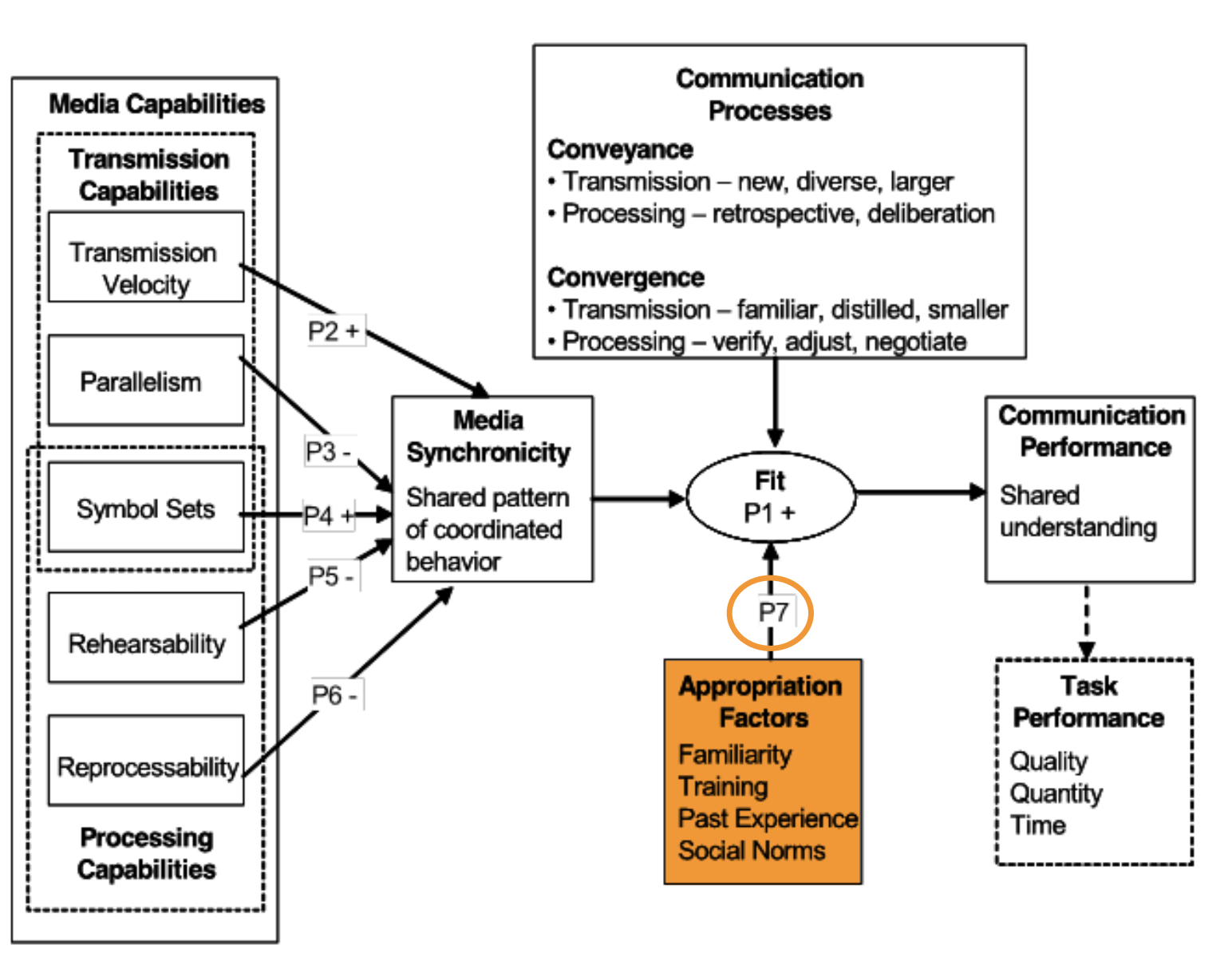
What is proposition 7?
P7: Although individuals working together on tasks will benefit from the use of both high and low synchronicity media, their need for media synchronicity will depend on their level of familiarity with each other, with the task, and with the media.
a. Individuals working together with well established norms working on familiar tasks using familiar media will have the least need to use media supporting high synchronicity.
b. Individuals working together without well established norms working on unfamiliar tasks using unfamiliar media will have the greatest need to use media supporting high synchronicity.
What is the goal, participation, agenda, artifacts, process, benefits, and preparation for team meetings, committee meetings, and workshops?
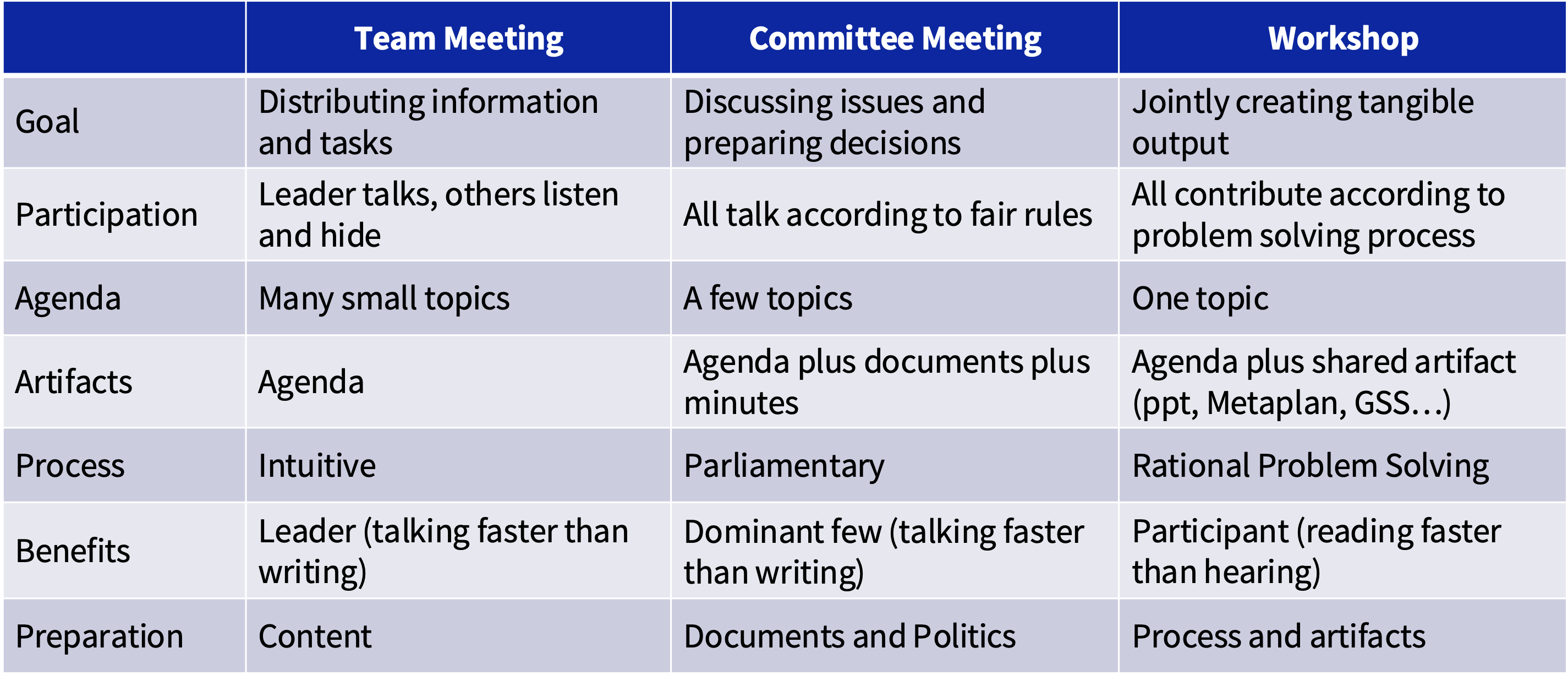
What is the workshop cycle model?

What are the facilitator’s functions?
Facilitators provide structures to establish a frame or context to activate individuals/group into a particular way of behaving. In a meeting context, structures primarily include the following:
1. Meeting outcomes.
2. Role specialization: participants are assigned specific roles (for example, devil's advocate, facilitator, decision-maker, and so on), for an activity, phase, or entire meeting.
3. Rules to follow during an activity, phase, or entire meeting.
4. Procedures to accomplish an entire meeting, a specific meeting phase, or a specific activity.
5. Techniques/technology to carry out procedures.
A facilitator works with the group leader (and participants) to establish meeting outcomes. The facilitator then designs the meeting by picking relevant roles, rules, procedures, and techniques to accomplish desired outcomes.
What kinds of contributions of group work systems exist?
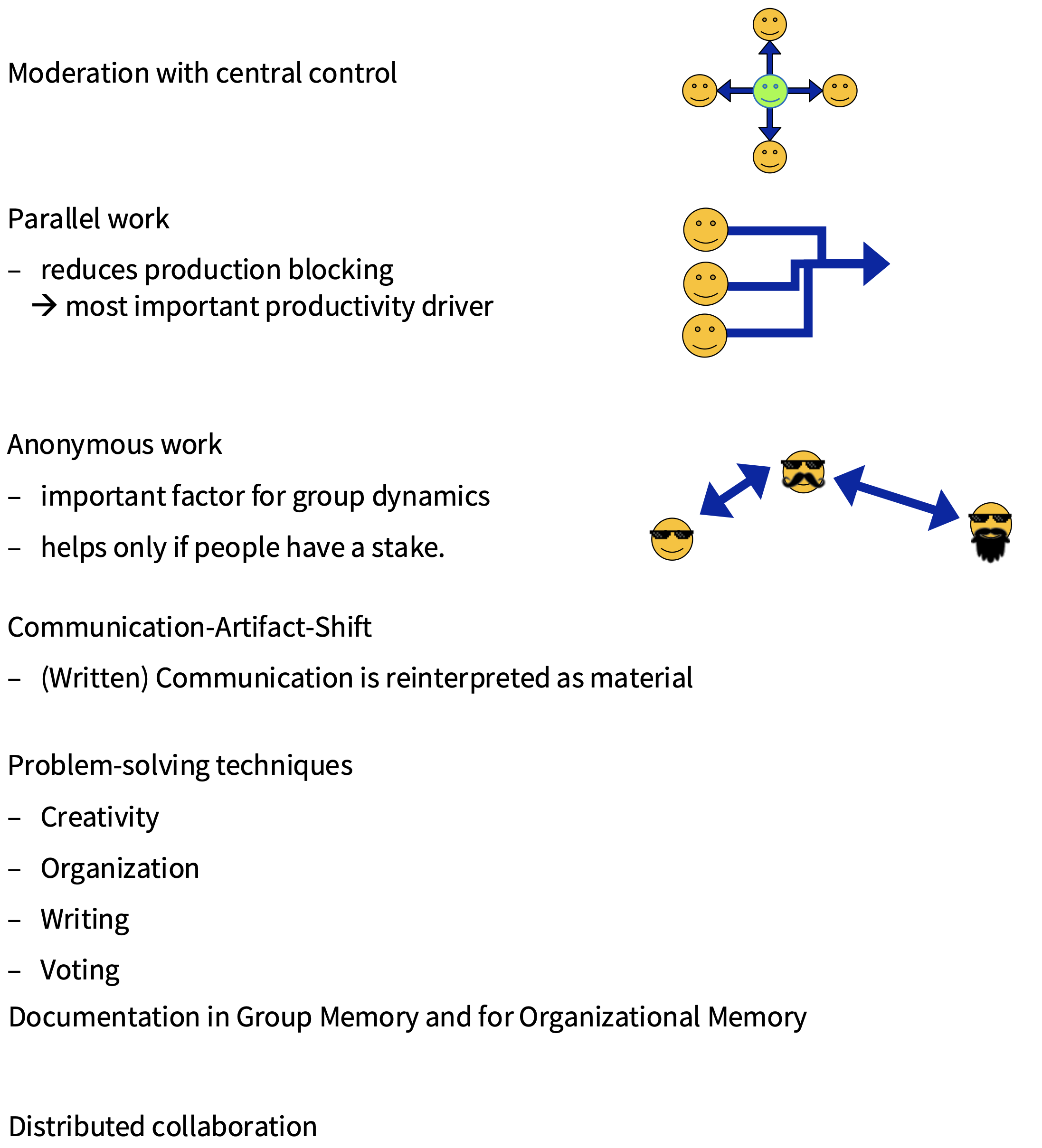
What is collaboration engineering?
– An approach
– To designing and deploying
– Recurring collaborative work practices
– For high-value recurring tasks
– And transferring them to practitioners
– To execute themselves without the ongoing intervention of a professional facilitator
What is the six-layer reference model of collaboration?
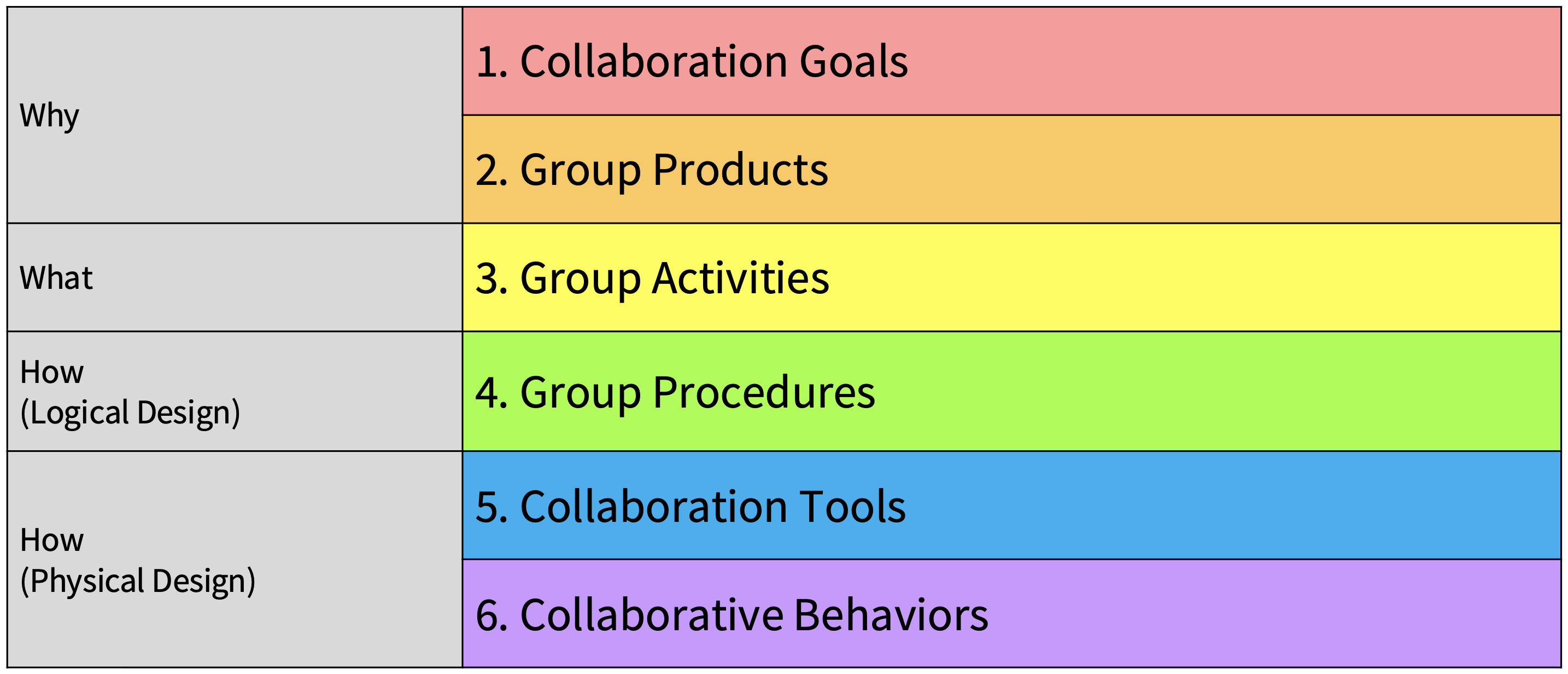
What is the goal of a problem solving workshop?
To move from the current state to the desired state.

What is the relationship between group goals and private goals?
The private goal of a car designer is for his designs to be recognized all around the world, while the private goal of a factory worker assembling the car is to earn money.
The factory worker would rather have 100 dollar bonus for each assembled car than a chrome plate with their name on the car they assembled. This is exactly the opposite for the car’s designer.
Private goals motivate effort towards group goals. The group goal in this case is to sell as many cars as possible. This can be done by motivating the workers and the designer by fulfilling their private goals.
What are design areas of the goal layer?
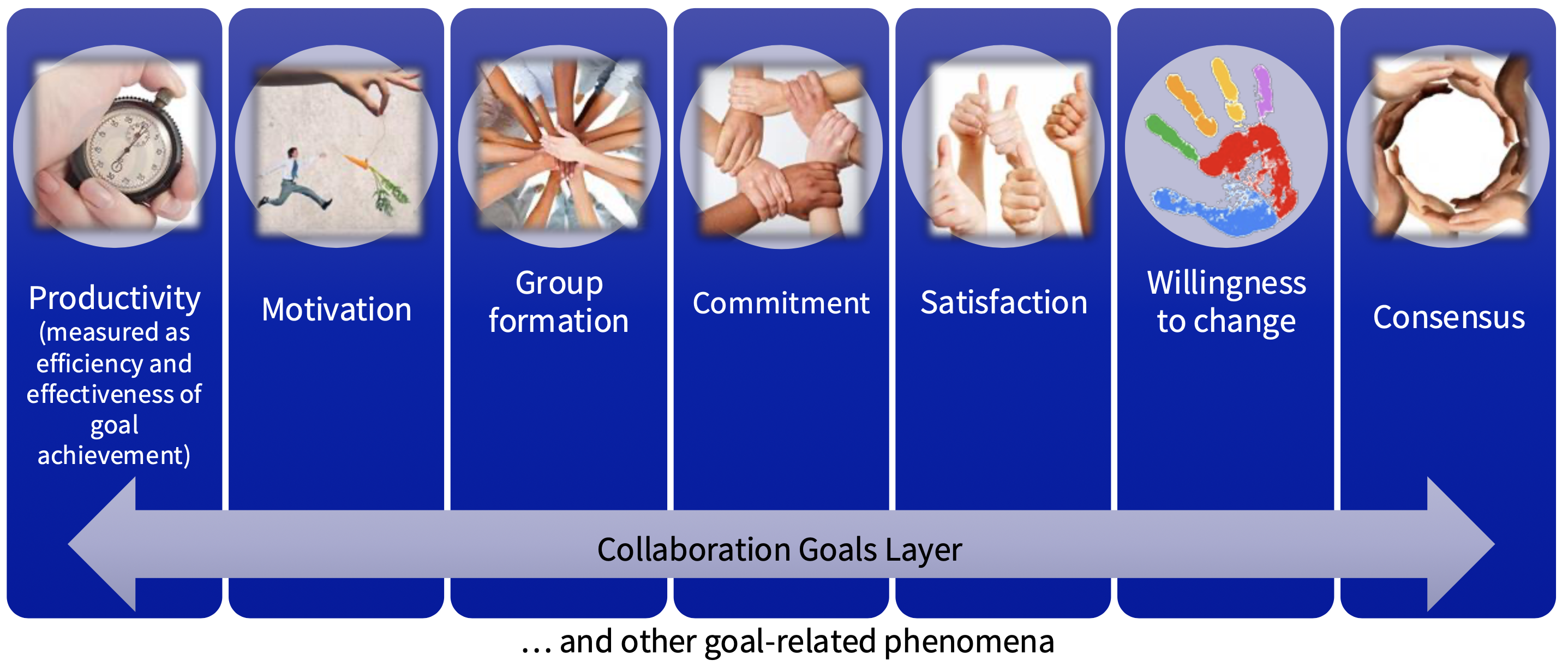
What is a group product and examples?
A product is a tangible object or intangible state produced by the group’s labor, the existence of which advances a group toward its goal.
Possible products (=tangible results):
– A list of problem statements?
– A list of possible solutions?
– A list of evaluation criteria? Evaluated solutions?
– An outline Choices and Rationale?
– Plans in the form of Gant-Chart?
– A prioritized list of actions?
– A text document of learnings = “after action review”?
What are issues and design areas at the product layer?

What are group activities?
Activities are sub-tasks that, when completed, yield the products that constitute attainment of the group goal.
The activities layer deals with what groups must do to achieve their goals: sequences of steps that constitute decision-making and problem-solving approaches.
What is the general goal attainment paradigm?
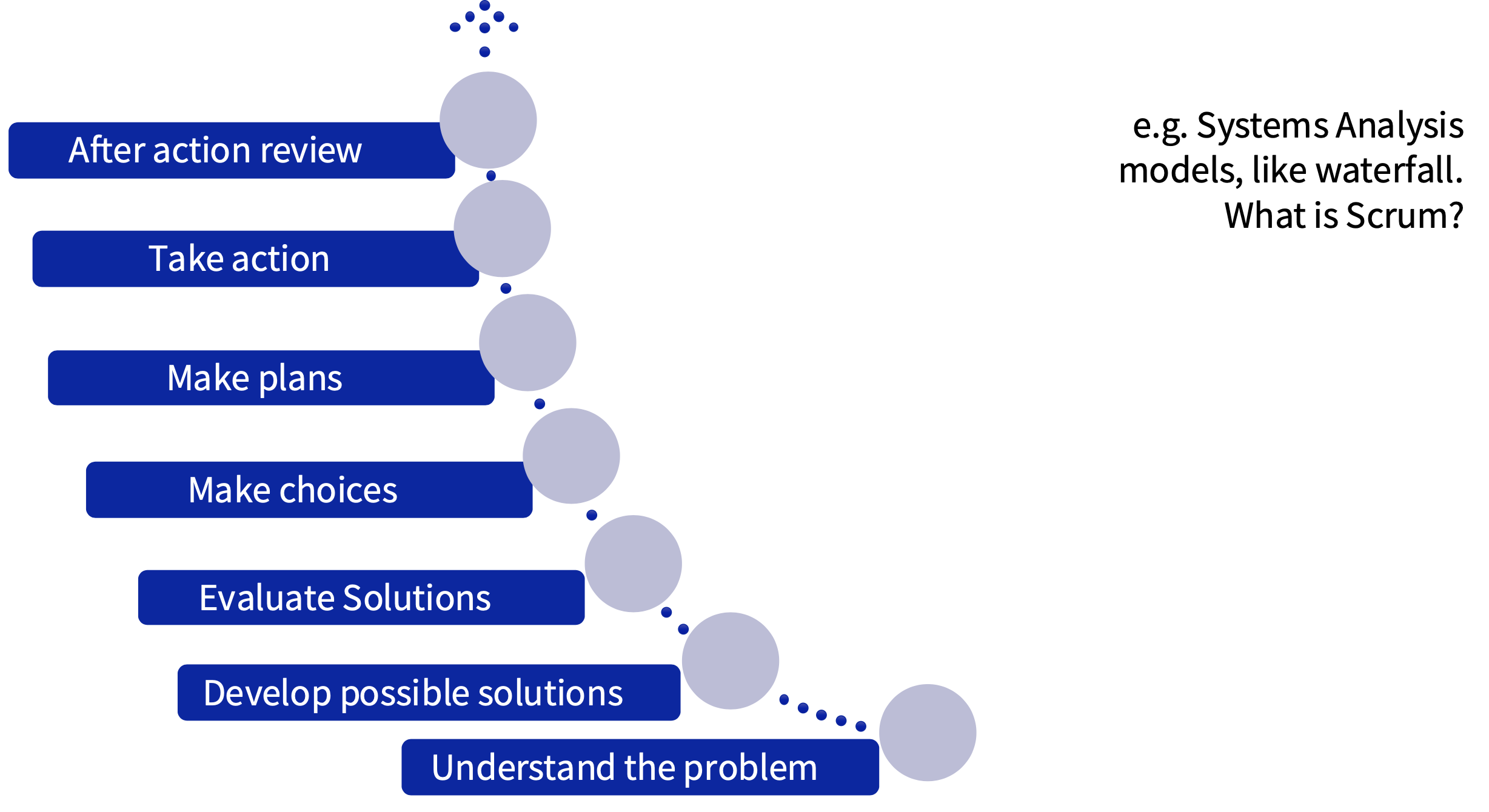
What are group procedures?
Group Procedures are the methods, strategies, and tactics a group uses to execute its work. A sequence of procedures characterizes how a group moves toward its goals. Procedures may be informal and emergent or formal and prescribed.
Procedures can be described at different levels of specificity, from abstract patterns of collaboration to detailed execution rules. At the most abstract level we speak of generic patterns of collaboration; at a more specific level we speak of techniques.
What are the six generic patterns of collaboration and how should they be used?
1. To reason about group procedures in an abstract way
2. To organize and select techniques for practical purposes
3. To organize and use research on group procedures
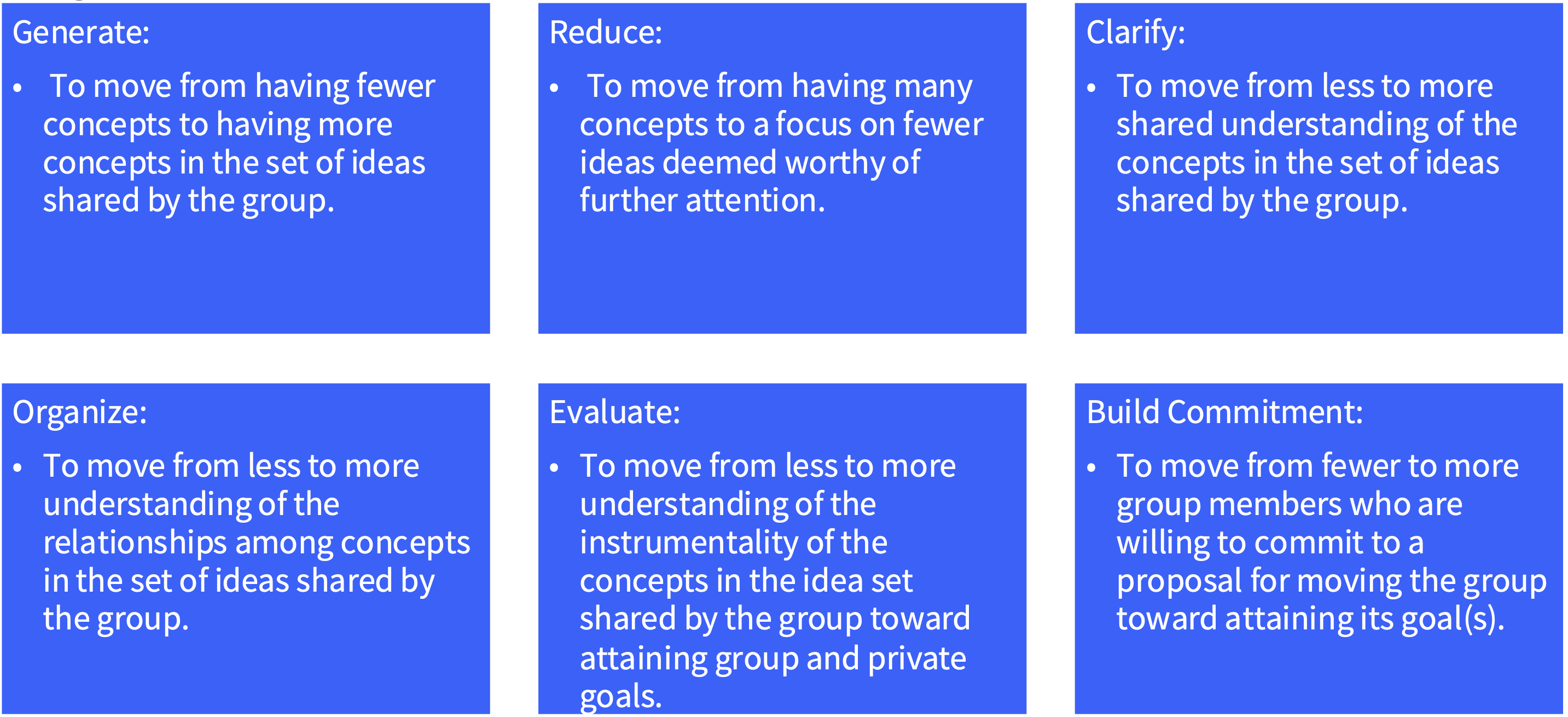
What are collaboration tools?
Collaboration tools are instruments or apparatus used in performing an operation for moving a group toward its goals, for example, whiteboards, flipcharts, or collaboration software systems. Collaboration tools afford users the capabilities they require to execute their work.
What kinds of collaboration tools exist?
Conventional tools (e.g. paper)
Generic electronic tools (e.g. Google Docs)
Specific electronic tools (e.g. tools used for a certain task)
Domain specific tools (e.g. tools that are used in certain environments)